CBSE Expert

Class 12 Physics Chapter 4 Case Study Question Moving Charges and Magnetism PDF Download
In Class 12 Boards there will be Case studies and Passage Based Questions will be asked, So practice these types of questions. Study Rate is always there to help you. Free PDF Download of CBSE Class 12 Physics Chapter 4 Moving Charges and Magnetism Case Study and Passage Based Questions with Answers were Prepared Based on Latest Exam Pattern. Students can solve NCERT Class 12 Physics Moving Charges and Magnetism to know their preparation level.

In CBSE Class 12 Physics Paper, Students will have to answer some questions based on Assertion and Reason . There will be a few questions based on case studies and passage-based as well. In that, a paragraph will be given, and then the MCQ questions based on it will be asked.
Moving Charges and Magnetism Case Study Questions With answers
Here, we have provided case-based/passage-based questions for Class 12 Physics Chapter 4 Moving Charges and Magnetism
Case Study/Passage-Based Questions
Question 1:

| (a) remains stationary |
| (b) spins about its own axis |
| (c) moves in the direction of the field |
| (d) moves perpendicular to the direction of the field. |
Answer: (a) remains stationary
(ii) A proton is projected with a uniform velocity v along the axis of a current carrying solenoid, then
| (a) the proton will be accelerated along the axis |
| (b) the proton path will be circular about the axis |
| (c) the proton moves along a helical path |
| (d) the proton will continue to move with velocity v along the axis. |
Answer: (d) the proton will continue to move with velocity v along the axis.
(iii) A charged particle experiences a magnetic force in the presence of the magnetic field. Which of the following statement is correct?
| (a) The particle is stationary and the magnetic field is perpendicular. |
| (b) The particle is moving and the magnetic field is perpendicular to the velocity |
| (c) The particle is stationary and the magnetic field is parallel |
| (d) The particle is moving and the magnetic field is parallel to the velocity |
Answer: (b) The particle is moving and the magnetic field is perpendicular to the velocity
(iv) A charge q moves with a velocity 2 ms -1 along the x-axis in a uniform magnetic field B⃗ =(i^+2j^+3k^)TB→=(i^+2j^+3k^)T then a charge will experience a force
| (a) in z-y plane | (b) along -yaxis | (c) along +z axis | (d) along -z axis |
Answer: (a) in z-y plane
(v) Moving charge will produce
| (a) electric field only | (b) magnetic field only |
| (c) both electric and magnetic field | (d) none of these. |
Answer: (c) both electric and magnetic field
Question 2:
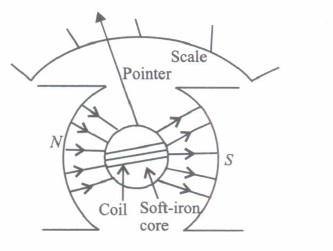
| (a) is used to measure emf |
| (b) is used to measure potential difference |
| (c) is used to measure resistance |
| (d) is a deflection instrument that gives a deflection when a current flows through its coil |
Answer: (d) is a deflection instrument that gives a deflection when a current flows through its coil
(ii) To make the field radial in a moving coil galvanometer
| (a) number of turns of the coil is kept small | (b) magnet is taken in the form of horse-shoe |
| (c) poles are of very strong magnets | (d) poles are cylindrically cut |
Answer: (d) poles are cylindrically cut
(iii) The deflection in a moving coil galvanometer is
| (a) directly proportional to the torsional constant of spring |
| (b) directly proportional to the number of turns in the coil |
| (c) inversely proportional to the area of the coil |
| (d) inversely proportional to the current in the coil |
Answer: (b) directly proportional to the number of turns in the coils
(iv) In a moving coil galvanometer, having a coil of N-turns of area A and carrying current I is placed in a radial field of strength B. The torque acting on the coil is
| (a) NA B I | (b) NABI | (c) N ABI | (d) NABI |
Answer: (d) NABI
(v) To increase the current sensitivity of a moving coil galvanometer, we should decrease
| (a) strength of magnet | (b) the torsional constant of spring |
| (c) number of turns in the coil | (d) area of coil |
Answer: (b) the torsional constant of spring
Hope the information shed above regarding Case Study and Passage Based Questions for Class 12 Physics Chapter 4 Moving Charges and Magnetism with Answers Pdf free download has been useful to an extent. If you have any other queries of CBSE Class 12 Physics Moving Charges and Magnetism Case Study and Passage Based Questions with Answers, feel free to comment below so that we can revert back to us at the earliest possible.
Leave a Comment Cancel reply
Save my name, email, and website in this browser for the next time I comment.
Download India's best Exam Preparation App Now.
Key Features
- Revision Notes
- Important Questions
- Previous Years Questions
- Case-Based Questions
- Assertion and Reason Questions
No thanks, I’m not interested!
Case Based Questions Test: Moving Charges & Magnetism - Grade 12 MCQ
15 questions mcq test - case based questions test: moving charges & magnetism, read the following text and answer the following questions on the basis of the same: roget’s spiral: magnetic effects are generally smaller than electric effects. as a consequence, the force between currents is rather small, because of the smallness of the factor μ. hence, it is difficult to demonstrate attraction or repulsion between currents. thus, for 5 a current in each wire at a separation of 1 cm, the force per metre would be 5 × 10–4 n, which is about 50 mg weight. it would be like pulling a wire by a string going over a pulley to which a 50 mg weight is attached. the displacement of the wire would be quite unnoticeable. with the use of a soft spring, we can increase the effective length of the parallel current and by using mercury, we can make the displacement of even a few mm observable very dramatically. you will also need a constant-current supply giving a constant current of about 5 a. take a soft spring whose natural period of oscillations is about 0.5–1 s. hang it vertically and attach a pointed tip to its lower end, as shown in the figure here. take some mercury in a dish and adjust the spring such that the tip is just above the mercury surface. take the dc current source, connect one of its terminals to the upper end of the spring and dip the other terminal in mercury. if the tip of the spring touches mercury, the circuit is completed through mercury. let the dc source be put off to begin with. let the tip be adjusted so that it just touches the mercury surface. switch on the constant current supply and watch the fascinating outcome. the spring shrinks with a jerk, the tip comes out of mercury (just by a mm or so), the circuit is broken, the current stops, the spring relaxes and tries to come back to its original position, the tip again touches mercury establishing a current in the circuit and the cycle continues with tick, tick, tick,... magnetic effects:.
- A. are equal to electric effects.
- B. are greater than electric effects.
- C. are smaller than electric effects.
- D. cannot be compared with electric effects.

Read the following text and answer the following questions on the basis of the same: Roget’s spiral: Magnetic effects are generally smaller than electric effects. As a consequence, the force between currents is rather small, because of the smallness of the factor μ. Hence, it is difficult to demonstrate attraction or repulsion between currents. Thus, for 5 A current in each wire at a separation of 1 cm, the force per metre would be 5 × 10–4 N, which is about 50 mg weight. It would be like pulling a wire by a string going over a pulley to which a 50 mg weight is attached. The displacement of the wire would be quite unnoticeable. With the use of a soft spring, we can increase the effective length of the parallel current and by using mercury, we can make the displacement of even a few mm observable very dramatically. You will also need a constant-current supply giving a constant current of about 5 A. Take a soft spring whose natural period of oscillations is about 0.5–1 s. Hang it vertically and attach a pointed tip to its lower end, as shown in the figure here. Take some mercury in a dish and adjust the spring such that the tip is just above the mercury surface. Take the DC current source, connect one of its terminals to the upper end of the spring and dip the other terminal in mercury. If the tip of the spring touches mercury, the circuit is completed through mercury. Let the DC source be put off to begin with. Let the tip be adjusted so that it just touches the mercury surface. Switch on the constant current supply and watch the fascinating outcome. The spring shrinks with a jerk, the tip comes out of mercury (just by a mm or so), the circuit is broken, the current stops, the spring relaxes and tries to come back to its original position, the tip again touches mercury establishing a current in the circuit and the cycle continues with tick, tick, tick,... Why the spring shrinks in Roget’s spiral ?
- A. The spring functions as a solenoid
- B. Due to force acting between two current carrying wires
- C. Due to magnetic effect of current
- D. Since the spring is soft
| 1 Crore+ students have signed up on EduRev. Have you? |
Read the following text and answer the following questions on the basis of the same: Roget’s spiral: Magnetic effects are generally smaller than electric effects. As a consequence, the force between currents is rather small, because of the smallness of the factor μ. Hence, it is difficult to demonstrate attraction or repulsion between currents. Thus, for 5 A current in each wire at a separation of 1 cm, the force per metre would be 5 × 10–4 N, which is about 50 mg weight. It would be like pulling a wire by a string going over a pulley to which a 50 mg weight is attached. The displacement of the wire would be quite unnoticeable. With the use of a soft spring, we can increase the effective length of the parallel current and by using mercury, we can make the displacement of even a few mm observable very dramatically. You will also need a constant-current supply giving a constant current of about 5 A. Take a soft spring whose natural period of oscillations is about 0.5–1 s. Hang it vertically and attach a pointed tip to its lower end, as shown in the figure here. Take some mercury in a dish and adjust the spring such that the tip is just above the mercury surface. Take the DC current source, connect one of its terminals to the upper end of the spring and dip the other terminal in mercury. If the tip of the spring touches mercury, the circuit is completed through mercury. Let the DC source be put off to begin with. Let the tip be adjusted so that it just touches the mercury surface. Switch on the constant current supply and watch the fascinating outcome. The spring shrinks with a jerk, the tip comes out of mercury (just by a mm or so), the circuit is broken, the current stops, the spring relaxes and tries to come back to its original position, the tip again touches mercury establishing a current in the circuit and the cycle continues with tick, tick, tick,... What else can be used instead of mercury in Roget’s spiral ?
- A. Any liquid
- C. Kerosene oil
- D. Only mercury, nothing else
Read the following text and answer the following questions on the basis of the same:
Galvanometer can sense/measure current. Improved mirror galvanometer was developed by William Thomson, later to become Lord Kelvin, in 1858. Thomson intended the instrument to read weak signal currents on very long submarine telegraph cables. The fundamental problems of transmitting/ receiving a signal through a lengthy submarine cable was that the electrical current tended to be very low (as little as 1/100,000th of a standard light bulb). So, it was very difficult to detect it. To solve the problem it was thought that larger amount of electric current would be sent through the line. But Thomson had a different approach. He thought the best response was to devise a device that could read faint signals. The galvanometer, first invented in 1802, was a means of detecting electric current. It consisted of a needle that was deflected by the magnetic field created by the electric current. But the galvanometers of the day couldn't detect the weak signals that came through a long underwater cable. But the improved version of galvanometer was highly sensitive to detect the lowest current. The mirror galvanometer consists of a long fine coil of silk-covered copper wire. In the heart of that coil, within a little air-chamber, a small round mirror is hung by a single fibre of floss silk, with four tiny magnets cemented to its back. A beam of light is thrown from a lamp upon the mirror, and reflected by it upon a white screen or scale a few feet distant, where it forms a bright spot of light; when there is no current on the instrument, the spot of light remains stationary at the zero position on the screen; but the instant a current traverses the long wire of the coil, the suspended magnets twist themselves horizontally out of their former position, the mirror is inclined with them, and the beam of light is deflected along the screen to one side or the other, according to the nature of the current. If a positive electric current gives a deflection to the right of zero, a negative current will give a deflection to the left of zero, and vice versa. The air in the little chamber surrounding the mirror is compressed, so as to act like a cushion, and deaden the movements of the mirror; the mirror is thus prevented from idly swinging about at each deflections.
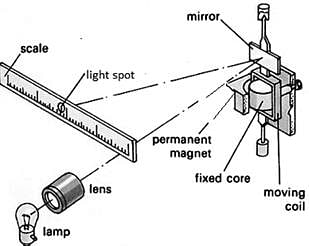
Improved mirror galvanometer was developed by
- A. Lord Kelvin
- B. Johann Schweigger
- C. Luigi Galvani
- D. André-Marie Ampère
Read the following text and answer the following questions on the basis of the same: Galvanometer can sense/measure current. Improved mirror galvanometer was developed by William Thomson, later to become Lord Kelvin, in 1858. Thomson intended the instrument to read weak signal currents on very long submarine telegraph cables. The fundamental problems of transmitting/ receiving a signal through a lengthy submarine cable was that the electrical current tended to be very low (as little as 1/100,000th of a standard light bulb). So, it was very difficult to detect it. To solve the problem it was thought that larger amount of electric current would be sent through the line. But Thomson had a different approach. He thought the best response was to devise a device that could read faint signals. The galvanometer, first invented in 1802, was a means of detecting electric current. It consisted of a needle that was deflected by the magnetic field created by the electric current. But the galvanometers of the day couldn't detect the weak signals that came through a long underwater cable. But the improved version of galvanometer was highly sensitive to detect the lowest current. The mirror galvanometer consists of a long fine coil of silk-covered copper wire. In the heart of that coil, within a little air-chamber, a small round mirror is hung by a single fibre of floss silk, with four tiny magnets cemented to its back. A beam of light is thrown from a lamp upon the mirror, and reflected by it upon a white screen or scale a few feet distant, where it forms a bright spot of light; when there is no current on the instrument, the spot of light remains stationary at the zero position on the screen; but the instant a current traverses the long wire of the coil, the suspended magnets twist themselves horizontally out of their former position, the mirror is inclined with them, and the beam of light is deflected along the screen to one side or the other, according to the nature of the current. If a positive electric current gives a deflection to the right of zero, a negative current will give a deflection to the left of zero, and vice versa. The air in the little chamber surrounding the mirror is compressed, so as to act like a cushion, and deaden the movements of the mirror; the mirror is thus prevented from idly swinging about at each deflections.
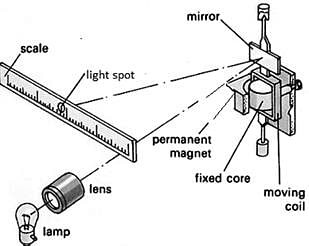
The basic principle of galvanometer is
heating effect of current.
magnetic effect of current.
torque developed by the electric current passing through a coil placed in magnetic feild.
none of the above.
The galvanometer was a means of detecting electric current. It consisted of a needle that was deflected by the magnetic field created by the electric current.
Read the following text and answer the following questions on the basis of the same: Galvanometer can sense/measure current. Improved mirror galvanometer was developed by William Thomson, later to become Lord Kelvin, in 1858. Thomson intended the instrument to read weak signal currents on very long submarine telegraph cables. The fundamental problems of transmitting/ receiving a signal through a lengthy submarine cable was that the electrical current tended to be very low (as little as 1/100,000th of a standard light bulb). So, it was very difficult to detect it. To solve the problem it was thought that larger amount of electric current would be sent through the line. But Thomson had a different approach. He thought the best response was to devise a device that could read faint signals. The galvanometer, first invented in 1802, was a means of detecting electric current. It consisted of a needle that was deflected by the magnetic field created by the electric current. But the galvanometers of the day couldn't detect the weak signals that came through a long underwater cable. But the improved version of galvanometer was highly sensitive to detect the lowest current. The mirror galvanometer consists of a long fine coil of silk-covered copper wire. In the heart of that coil, within a little air-chamber, a small round mirror is hung by a single fibre of floss silk, with four tiny magnets cemented to its back. A beam of light is thrown from a lamp upon the mirror, and reflected by it upon a white screen or scale a few feet distant, where it forms a bright spot of light; when there is no current on the instrument, the spot of light remains stationary at the zero position on the screen; but the instant a current traverses the long wire of the coil, the suspended magnets twist themselves horizontally out of their former position, the mirror is inclined with them, and the beam of light is deflected along the screen to one side or the other, according to the nature of the current. If a positive electric current gives a deflection to the right of zero, a negative current will give a deflection to the left of zero, and vice versa. The air in the little chamber surrounding the mirror is compressed, so as to act like a cushion, and deaden the movements of the mirror; the mirror is thus prevented from idly swinging about at each deflections.
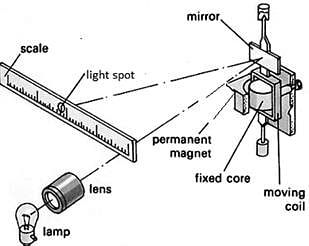
How the idly swinging of the mirror of mirror galvanometer is prevented?
- A. The little chamber surrounding the mirror was filled with a viscous liquid
- B. The mirror was placed in little chamber which was completely vacuum
- C. The mirror was attached to a spring
- D. The little chamber surrounding the mirror was filled with compressed air
A toroid is a coil of insulated or enamelled wire wound on a donut-shaped form made of powdered iron. A toroid is used as an inductor in electronic circuits, especially at low frequencies where comparatively large inductances are necessary. A toroid has more inductance , for a given number of turns, than a solenoid with a core of the same material and similar size. This makes it possible to construct high-inductance coils of reasonable physical size and mass. Toroidal coils of a given inductance can carry more current than solenoidal coils of similar size, because larger-diameter wires can be used, and the total amount of wire is less, reducing the resistance . In a toroid, all the magnetic flux is contained in the core material. This is because the core has no ends from which flux might leak off. The confinement of the flux prevents external magnetic fields from affecting the behaviour of the toroid, and also prevents the magnetic field in the toroid from affecting other components in a circuit. Standard toroidal transformers typically offer a 95% efficiency, while standard laminated transformers typically offer less than a 90% rating. One of the most important differences between a toroidal transformer and a traditional laminated transformer is the absence of gaps. The leakage flux through the gaps contributes to the stray losses in the form of eddy currents (which is also expelled in the form of heat). A toroidal core doesn’t have an air gap. The core is tightly wound . The result is a stable, predictable toroidal core, free from discontinuities and holes. Audible vibration or hum in transformers is caused by vibration of the windings and core layers from the forces between the coil turns and core laminations. The toroidal transformer’s construction helps quiet this noise. In audio, or signal transmitting applications, unwarranted noise will affect sound quality, so a transformer with low audible vibration is ideal. For this reason, many sound system engineers prefer to use a toroidal transformer instead of a traditional laminated transformer.
Toroid is a
- A. fixed value resistor.
- B. capacitor.
- C. inductor.
- D. variable resistor.
Read the following text and answer the following questions on the basis of the same: TOROID
Why inductance of solenoid is more than the inductance of a solenoid having same number of turns, core of same material and similar size?
- A. Core is endless hence there no leakage of flux.
- B. Resistance of wire is less hence magnitude of current flow is more
- C. Number of turns per unit length is more.
- D. Both (A) and (B)
Efficiency of toroidal transformer is around ______ % which is ______ than laminated core transformer.
- A. 95, lower
- B. 95, higher
- C. 50, lower
- D. 80, higher
Read the following text and answer the following questions on the basis of the same: Roget’s spiral: Magnetic effects are generally smaller than electric effects. As a consequence, the force between currents is rather small, because of the smallness of the factor μ. Hence, it is difficult to demonstrate attraction or repulsion between currents. Thus, for 5 A current in each wire at a separation of 1 cm, the force per metre would be 5 × 10–4 N, which is about 50 mg weight. It would be like pulling a wire by a string going over a pulley to which a 50 mg weight is attached. The displacement of the wire would be quite unnoticeable. With the use of a soft spring, we can increase the effective length of the parallel current and by using mercury, we can make the displacement of even a few mm observable very dramatically. You will also need a constant-current supply giving a constant current of about 5 A. Take a soft spring whose natural period of oscillations is about 0.5–1 s. Hang it vertically and attach a pointed tip to its lower end, as shown in the figure here. Take some mercury in a dish and adjust the spring such that the tip is just above the mercury surface. Take the DC current source, connect one of its terminals to the upper end of the spring and dip the other terminal in mercury. If the tip of the spring touches mercury, the circuit is completed through mercury. Let the DC source be put off to begin with. Let the tip be adjusted so that it just touches the mercury surface. Switch on the constant current supply and watch the fascinating outcome. The spring shrinks with a jerk, the tip comes out of mercury (just by a mm or so), the circuit is broken, the current stops, the spring relaxes and tries to come back to its original position, the tip again touches mercury establishing a current in the circuit and the cycle continues with tick, tick, tick,...
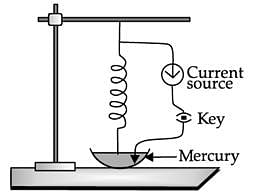
The force 10 –3 N,is equivalent to:
∴ Mass = 10 –4 kg = 100 mg
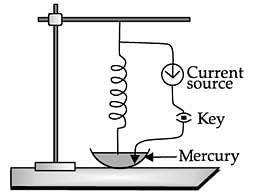
What are the main 3 components in a Roget’s spiral?
- A. Mercury, AC voltage source
- B. Mercury, DC voltage source
- C. Mercury, DC voltage source, key
- D. Mercury, AC voltage source, key

Mirror galvanometer was primarily used to
- A. measure the current passing through electric bulb.
- B. measure the weak current received through lengthy submarine cable.
- C. measure current passing through human body.
- D. all of these.
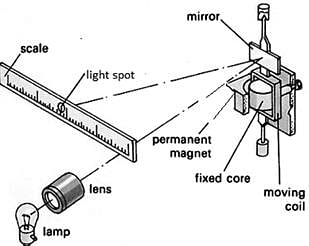
The mirror galvanometer consists of
- A. a small round mirror attached to a fine coil of silk-covered copper wire.
- B. a long fine coil of silk-covered copper wire and a small round mirror hung by a single fibre of floss silk, with four tiny magnets cemented to its back.
- C. a small round mirror attached to four tiny magnets.
- D. None of the above
A toroid has _____ inductance, for a given number of turns, than a solenoid with a core of the same material and similar size.
- D. variable
Why sound system engineers prefer to use toroidal transformer?
- A. It is cheaper.
- B. It is lighter.
- C. It is compact.
- D. It does not create vibration or hum.
Top Courses for Grade 12

Important Questions for Case Based Questions Test: Moving Charges & Magnetism
Case based questions test: moving charges & magnetism mcqs with answers, online tests for case based questions test: moving charges & magnetism.
| cation olution |
| Join the 10M+ students on EduRev |
Welcome Back
Create your account for free.

Forgot Password
NCERT Solutions for Class 6, 7, 8, 9, 10, 11 and 12
Important Questions for Class 12 Physics Chapter 4 Moving Charges and Magnetism Class 12 Important Questions
December 6, 2019 by Sastry CBSE
Moving Charges and Magnetism Class 12 Important Questions Very Short Answer Type
Question 2. Why should the spring/suspension wire in a moving coil galvanometer have low torsional constant? (All India 2008) Answer: Low torsional constant is basically required to increase the current/charge sensitivity in a moving coil ballistic galvanometer.
Question 3. Magnetic field lines can be entirely confined within the core of a toroid, but not within a straight solenoid. Why? (Delhi 2008) Answer: At the edges of the solenoid, the field lines get diverged due to other fields and/or non-availability of dipole loops, while in toroids the dipoles (in loops) orient continuously.
Question 14. Why do the electrostatic field lines not form closed loops? (All India 2015) Answer: Electric field lines do not form closed loops because the direction of an electric field is from positive to negative charge. So one can regard a line of force starting from a positive charge and ending on a negative charge. This indicates that electric field lines do not form closed loops.
Question 15. A particle of mass ‘m’ and charge ‘q’ moving with velocity V enters the region of uniform magnetic field at right angle to the direction of its motion. How does its kinetic energy get affected? (Comptt. Delhi 2015) Answer: Kinetic energy will NOT be affected. *(When \(\vec{v}\) is perpendicular to \(\vec{B}\), then magnetic field provides necessary centripetal force)
Question 17. A coil, of area A, carrying a steady current I, has a magnetic moment, \(\vec{m}\), associated with it. Write the relation between \(\vec{m}\), I and A in vector form. (Comptt Delhi 2015) Answer: Relation for magnetic moment = \(\vec{m}\) = I\(\vec{A}\)
Moving Charges and Magnetism Class 12 Important Questions Short Answer Type SA II
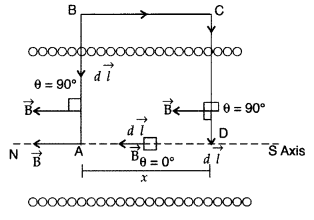
Question 34. (a) How is a toroid different from a solenoid? (b) Use Ampere’s circuital law to obtain the magnetic field inside a toroid. (c) Show that in an ideal toroid, the magnetic field (i) inside the toroid and (ii) outside the toroid at any point in the open space is zero. (Comptt. All India 2014) Answer: (a) A toroid is essentially a solenoid which has been bent into a circular shape to close on itself. (b)
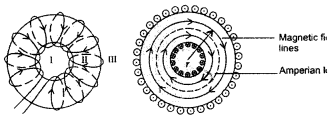
Question 42. Find the condition under which the charged particles moving with different speeds in the presence of electric and magnetic field vectors can be used to select charged particles of a particular speed. (All India 2015) Answer: Condition: The velocity \(\vec{v}\) of the charged particles, and the \(\overrightarrow{\mathrm{E}}\) and \(\overrightarrow{\mathrm{B}}\) vectors, should be mutually perpendicular
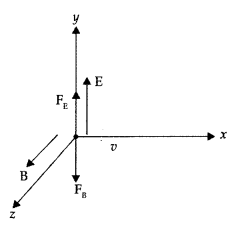
Moving Charges and Magnetism Class 12 Important Questions Short Answer Type SA III

Direction : Towards the conductor/Attractive Net force on the loop will act towards the long conductor (attractive) if the current in its closer side is in the same direction as the current in the long conductor, otherwise it will be repulsive.
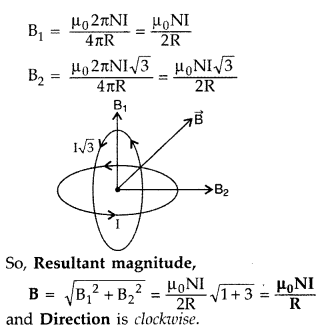
Justification : Component of velocity \(\vec{v}\), parallel to magnetic field, will make the particle move along the field.
Perpendicular component of velocity \(\vec{v}\) will cause the particle to move along a circular path in the plane perpendicular to the magnetic field Hence, the particle will follow a helical path, as shown above.
Question 67. A uniform magnetic field \(\overrightarrow{\mathrm{B}}\) is set up along the positive x-axis. A particle of charge ‘q’ and mass ‘m’ moving with a velocity v enters the field at the origin in X-Y plane such that it has velocity components both along and perpendicular to the magnetic field \(\overrightarrow{\mathrm{B}}\). Trace, giving reason, the trajectory followed by the particle. Find out the expression for the distance moved by the particle along the magnetic field in one rotation. (All India 2014) Answer: Since the velocity of the particle is inclined to x-axis, thererfore, the velocity has a component along B, this component remains unchanged as the motion along the magnetic field will not be affected by the magnetic field. The motion in a plane perpendicular to B is as before a circular one, thereby producing a helical motion, which is its trajectory.
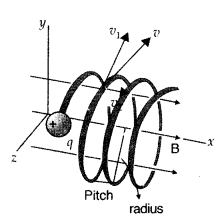
Working. When current is passed, say along ABCD, the couple acts on it. Since the plane remains always parallel to the magnetic field in all positions of the coil (radial field), the force on the vertical arms always remains perpendicular to the place of the coil.
Let, I be the current flowing through coil, B be magnetic field supposed to be uniform and always parallel to the coil, A be area of the coil Deflecting torque acting on the coil is, τ = nI BA sin 900
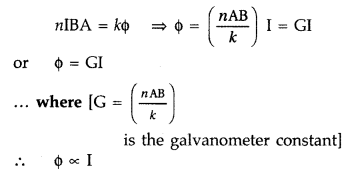
Moving Charges and Magnetism Class 12 Important Questions Long Answer Type
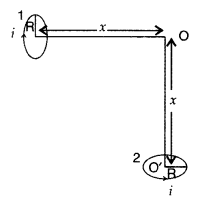
(b) For radial magnetic field, sin θ = 1, so torque τ = NIAB. Thus when radial magnetic field is used, the deflection of the coil is proportional to the current flowing through it. Hence a linear scale can be used to determine the deflection of the coil.
(c) A high resistance is joined in series with a galvanometer so that when the arrangement (voltmeter) is used in parallel with the selected section of the circuit, it should draw least amount of current. In case voltmeter draws appreciable amount of current, it will disturb the original value of potential difference by a good amount.
To convert a galvanometer into ammeter, a shunt is used in parallel with it so that when the arrangement is joined in series, the maximum current flows through the shunt, and thus the galvanometer is saved from its damage, when the current is passed through ammeter.
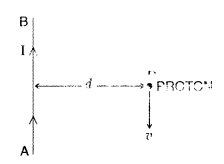
Yes, there is an upper limit. The increase in the kinetic energy of particles is qv. Therefore, the radius of their path goes on increasing each time, their kinetic energy increases. The lines are repeatedly accelerated across the dees, untill they have the required energy to have a radius approximately that of the dees. Hence, this is the upper limit on the energy required by the particles due to definite size of dees.
(b) Since \(\mathrm{v}_{\mathrm{s}}=\frac{\mathrm{I}_{\mathrm{s}}}{\mathrm{R}}\) increase in current sensitivity may not necessarily increase the voltage sensitivity. It may be affected by the resistance used.
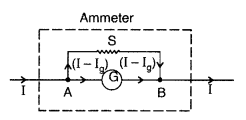
Question 99. (a) Write the expression for the force, \(\overrightarrow{\mathbf{F}}\), acting on a charged particle of charge ‘q’, moving with a velocity latex]\overrightarrow{\mathbf{v}}[/latex] in the presence of both electric field \(\overrightarrow{\mathrm{E}}\) and magnetic field \(\overrightarrow{\mathrm{B}}\). Obtain the condition under which the particle moves undeflected through the fields. (b) A rectangular loop of size l × b carrying a steady current I is placed in a uniform magnetic field \(\overrightarrow{\mathrm{B}}\). Prove that the torque \(\vec{\tau}\) acting on the loop is given by \(\vec{\tau}=\vec{m} \times \overrightarrow{\mathrm{B}}\), where \(\overrightarrow{\mathrm{m}}\) is the magnetic moment of the loop. (All India 2011) Answer: (a) A charge q in an electric field \(\overrightarrow{\mathrm{E}}\) experiences the electric force, \(\overrightarrow{\mathrm{F}}_{e}=q \overrightarrow{\mathrm{E}}\)
This force acts in the direction of field \(\overrightarrow{\mathrm{E}}\) and is independent of the velocity of the charge.
On the other hand, dB sin θ component of magnetic field due to each element of the coil or loop is directed in the same direction.
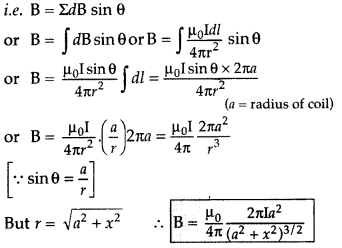
Important Questions for Class 12 Physics
Free resources.
NCERT Solutions
Quick Resources
- New QB365-SLMS
- 12th Standard Materials
- 11th Standard Materials
- 10th Standard Materials
- 9th Standard Materials
- 8th Standard Materials
- 7th Standard Materials
- 6th Standard Materials
- 12th Standard CBSE Materials
- 11th Standard CBSE Materials
- 10th Standard CBSE Materials
- 9th Standard CBSE Materials
- 8th Standard CBSE Materials
- 7th Standard CBSE Materials
- 6th Standard CBSE Materials
- Tamilnadu Stateboard
- Scholarship Exams
- Scholarships

Class 12th Physics - Moving Charges And Magnetism Case Study Questions and Answers 2022 - 2023
By QB365 on 09 Sep, 2022
QB365 provides a detailed and simple solution for every Possible Case Study Questions in Class 12th Physics Subject - Moving Charges And Magnetism, CBSE. It will help Students to get more practice questions, Students can Practice these question papers in addition to score best marks.
QB365 - Question Bank Software
Moving charges and magnetism case study questions with answer key.
12th Standard CBSE
Final Semester - June 2015

(ii) Radius of particle in second magnetic field B o is
(iii) Which of the following will trace a circular trajectory wit largest radius?
| particle |
(iv) Mass of the particle in terms q, B o, B,r and E is
(v) The particle comes out of velocity selector along a straight line, because

(ii) The magnetic field at a distance r in the region r < R is

(v) A direct current I flows along the length of an infinitely long straight thin walled pipe, then the magnetic field is
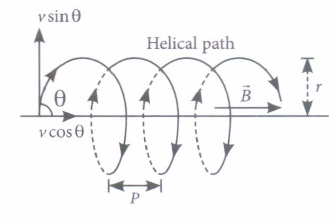
(ii) Two charged particles A and B having the same charge, mass and speed enter into a magnetic field in such a way that the initial path of A makes an angle of 30° and that of B makes an angle of 90° with the field. Then the trajectory of
(iii) An electron having momentum 2.4 x 10 -23 kg m/ s enters a region of uniform magnetic field of 0.15 T. The field vector makes an angle of 30° with the initial velocity vector of the electron. The radius of the helical path of the electron in the field shall be
(iv) The magnetic field in a certain region of space is given by \(\vec{B}=8.35 \times 10^{-2} \hat{i}\) T. A proton is shot into the field with velocity \(\vec{v}=\left(2 \times 10^{5} \hat{i}+4 \times 10^{5} \hat{j}\right) \mathrm{m} / \mathrm{s}\) The proton follows a helical path in the field. The distance moved by proton in the x-direction during the period of one revolution in the yz-plane will be (Mass of proton = 1.67 x 10 -27 kg)
(v) The frequency of revolution of the particle is
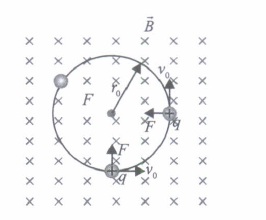
(ii) If v o = 2v o then the time required for one revolution of the electron will change to
(iii) A charged particles is projected in a magnetic field \(\vec{B}=(2 \hat{i}+4 \hat{j}) \times 10^{2} \mathrm{~T}\) The acceleration of the particle is found to be \(\vec{a}=(x \hat{i}+2 \hat{j}) \mathrm{m} \mathrm{s}^{-2}\) . Find the value of x.
(iv) If the given electron has a velocity not perpendicular to B, then trajectory of the electron is
(v) If this electron of charge (e) is moving parallel to uniform magnetic field with constant velocity v, the force acting on the electron is
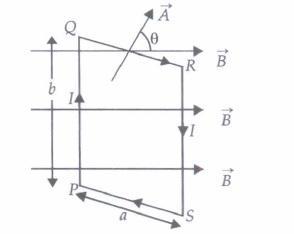
| N m | N m |
(ii) Relation between magnetic moment and angular velocity is
(ill) A current loop in a magnetic field
(iv) The magnetic moment of a current I carrying circular coil of radius r and number of turns N varies as
(v) A rectangular coil carrying current is placed in a non-uniform magnetic field. On that coil the total
(i) (c): In mass spectrometer, the ions are sorted out by accelerating them through electric and magnetic field.
A magnetic field can be produced by moving, charges or electric currents. The basic equation governing the magnetic field due to a current distribution is the Biot-Savart law. Finding the magnetic field resulting from a current distribution involves the vector product, and is inherently a calculas problem when the distance from the current to the field point is continuously changing. According to this law, the magnetic field at a point due to a current element oflength \(d \vec{l}\) carrying current I, at a distance r from the element is \(d B=\frac{\mu_{0}}{4 \pi} \frac{I(d \vec{l} \times \vec{r})}{r^{3}}\) Biot -Savart law has certain similarities as well as difference with Coloumbs law for electrostatic field e.g., there is an angle dependence in Biot-Savart law which is not present in electrostatic case. (i) The direction of magnetic field \(d \vec{B}\) due to a current element \(I d \vec{l}\) at a point of distance \(\vec{r}\) from it, when a current I passes through a long conductor is in the direction
(ii) The magnetic field due to a current in a straight wire segment of length L at a point on its perpendicular bisector at a distance r (r >> L)
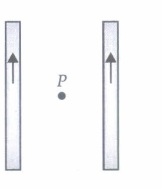
| \(\text { (a) } \mu_{0} i / r\) | \(\text { (b) } 4 \mu_{0} i / r\) |
| (c) zero | \(\text { (d) } \mu_{0} i / 4 r\) |
(iv) A long straight wire carries a current along the z-axis for any two points in the x - y plane. Which of the following is always false?
(v) Biot-Savart law can be expressed alternatively as
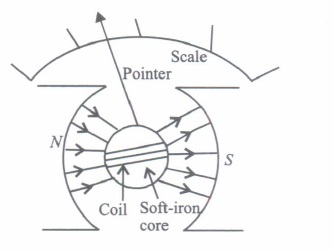
(ii) To make the field radial in a moving coil galvanometer
(iii) The deflection in a moving coil galvanometer is
(iv) In a moving coil galvanometer, having a coil of N-turns of area A and carrying current I is placed in a radial field of strength B. The torque acting on the coil is
(v) To increase the current sensitivity of a moving coil galvanometer, we should decrease

(ii) There are 3 voltmeter A, B, C having the same range but their resistance are \(15,000 \Omega, 10,000 \Omega\) and \(5,000 \Omega\) respectively. The best voltmeter amongst them is the one whose resistance is
(iii) A milliammeter of range 0 to 25 mA and resistance of \(10 \Omega\) is to be converted into a voltmeter with a range of 0 to 25 V. The resistance that should be connected in series will be
(iv) To convert a moving coil galvanometer (MCG) into a voltmeter
(v) The resistance of an ideal voltmeter is
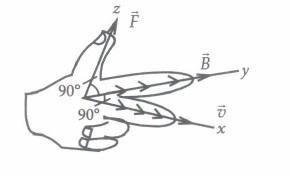
(ii) A proton is projected with a uniform velocity v along the axis of a current carrying solenoid, then
(iii) A charged particle experiences magnetic force in the presence of magnetic field. Which of the following statement is correct?
(iv) A charge q moves with a velocity 2 ms -1 along x-axis in a uniform magnetic field \(\vec{B}=(\hat{i}+2 \hat{j}+3 \hat{k}) \mathrm{T}\) then charge will experience a force
(v) Moving charge will produce

| T | T | T | T |
(ii) Choose the correct statement in the following
(iii) The magnetic field (B) inside a long solenoid having n turns per unit length and carrying current I when iron core is kept in it is \(\left(\mu_{0}=\text { permeability of vacuum, } \chi=\right.\text { magnetic susceptibility) }\)
(iv) A solenoid oflength I and having n turns carries a current I is in anticlockwise direction. The magnetic field is
(v) The magnitude of the magnetic field inside a long solenoid is increased by
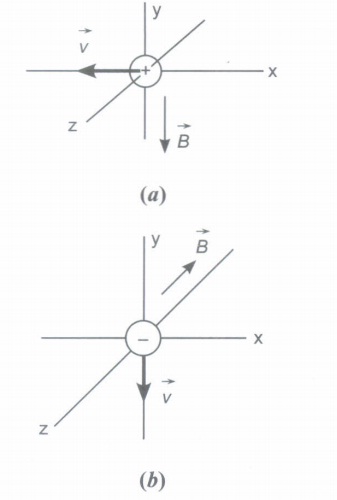
*****************************************
Moving charges and magnetism case study questions with answer key answer keys.
(i) (c): In mass spectrometer, the ions are sorted out by accelerating them through electric and magnetic field. (ii) (c): As \(\frac{m v^{2}}{r}=q v B_{0} \therefore r=\frac{m v}{q B_{0}}\) (iii) (b): As radius \(r \propto \frac{m}{q}\) \(\therefore\) r will be maximum for \(\alpha\) - particle. (iv) (b) : Here, \(r=\frac{m v}{q B_{0}} \text { or } m=\frac{r q B_{0}}{v}\) As \(v=\frac{E}{B}, \therefore m=\frac{q B_{0} B r}{E}\) (v) (c): From the relation v = E/B, it is clear electric and magnetic force balance each other.

(i) (b) : As \(r_{0}=\frac{m v}{q B} \Rightarrow r^{\prime}=\frac{m\left(2 v_{0}\right)}{q B}=2 r_{0}\) (ii) (c): As, \(T=\frac{2 \pi m}{q B}\) Thus, it remains same as it is in dependent of velocity (iii) (b) : As \(F \perp B\) Hence, \(a \perp B\) \(\therefore \vec{a} \cdot \vec{B}=0\) \(\Rightarrow \quad(x \hat{i}+2 \hat{j}) \cdot(2 \hat{i}+4 \hat{j})=0\) \(2 x+8=0 \Rightarrow x=-4 \mathrm{~m} \mathrm{~s}^{-2}\) (iv) (c): If the charged particle has a velocity not perpendicular to \(\vec{B},\) then component of velocity along \(\vec{B}\) remains unchanged as the motion along the \(\vec{B}\) will not be affected by \(\vec{B}\) . Then, the motion of the particle in a plane perpendicular to \(\vec{B}\) is as before circular one. Thereby, producing helical motion. (v) (d): The force on electron \(F=q v B \sin \theta\) As the electron is moving parallel to B So, \(\theta=0^{\circ} \Rightarrow q v B \sin 0^{\circ}=0\)
(I) (a): Torque on a current carrying loop in magnetic field \(\tau=I B A \sin \theta\) Here, \(I=10 \mathrm{~A}, B=0.1 \mathrm{~T}, A=1 \mathrm{~cm}^{2}=10^{-4} \mathrm{~m}^{2}, \theta=0^{\circ}\) \(\therefore \quad \tau=10 \times 0.1 \times 10^{-4} \sin 0^{\circ}=0\) (ii) (a) : Magnetic moment, \(M=I A=I\left(\pi r^{2}\right)=\frac{q}{T} \times \pi r^{2}\) \(\text { As } \omega=\frac{2 \pi}{T} \quad \therefore \quad M=\frac{q \omega r^{2}}{2} \quad \text { or } \quad M \propto \omega\) (iii) (b): When a current loop is placed in a magnetic field it experiences a torque. It is given by \(\vec{\tau}=\vec{M} \times \vec{B}\) where \(\vec{M}\) is the magnetic moment of the loop and \(\vec{B}\) is the magnetic field. or \(\tau=M B \sin \theta\) where \(\theta\) is angle between Mand B When \(\vec{M}\) and \(\vec{B}\) are parallel \(\text { (i.e. } \theta=0^{\circ} \text { ) }\) the equilibrium is stable and when they are antiparallel \((\text { i.e. } \theta=\pi)\) the equilibrium is unstable (iv) (d) : Magnetic moment \(M=N I A=N I \pi r^{2} \text { i.e. }\) \(M \propto r^{2}\) (v) (a)
(i) (c): According to Biot -Savart's law, the magnetic induction due to a current element is given by \(d \vec{B}=\frac{\mu_{0}}{4 \pi} \frac{I d \vec{l} \times \vec{r}}{r^{3}}\) This is perpendicular to both \(d \vec{l} \text { and } \vec{r}\) (ii) (b): From Biot-savart's law, \(d B=\frac{\mu_{0}}{4 \pi} \frac{I d l}{r^{2}} \text { i.e. } d B \propto \frac{1}{r^{2}}\) (iii) (c): \(B=\frac{\mu_{0}}{2 \pi} \cdot \frac{i}{r}-\frac{\mu_{0}}{2 \pi} \cdot \frac{i}{r}=0\) (iv) (a) (v) (b): Biot-Savart law can be expressed alternatively as Ampere circuital law.
(I) (d): A moving coil galvanometer is a sensitive instrument which is used to measure a deflection when a current flows through its coil. (ii) (d) : Uniform field is made radial by cutting pole pieces cylindrically. (iii) (b): The deflection in a moving coil galvanometer \(\phi=\frac{N A B}{k} \cdot I \text { or } \phi \propto N\) where Nis number of turns in a coil, B is magnetic field and A is area of cross-section. (iv) (d): The deflecting torque acting on the coil \(\tau_{\text {deflection }}=N I A B\) (v) (b): Current sensitivity of galvanometer \(\frac{\phi}{I}=S_{i}=\frac{N B A}{k}\) Hence, to increase (current sensitivity) S i (torsional constant of spring) k must be decrease.
(i) (d) : A galvanometer can be converted into a voltmeter of given range by connecting a suitable high resistance R in series of galvanometer, which is given by \(R=\frac{V}{I_{g}}-G=\frac{100}{10 \times 10^{-3}}-25=10000-25=9975 \Omega\) (ii) (c): An ideal voltmeter should have a very high resistance. (iii) (c): Resistance of voltmeter \(=\frac{25}{25 \times 10^{-3}}=1000 \Omega\) \(\therefore \quad X=1000-10=990 \Omega\) (iv) (d) : To convert a moving coil galvanometer into a voltmeter, it is connected with a high resistance in series. The voltmeter is connected in parallel to measure the potential difference. As the resistance is high, the voltmeter itself does not consume current. (v) (d): The resistance of an ideal voltmeter is infinity.
(i) (a): For stationary electron, \(\vec{v}=0\) \(\therefore\) Force on the electron is \(\vec{F}_{m}=-e(\vec{v} \times \vec{B})=0\) (ii) (d) : Force on the proton \(\vec{F}_{B}=e(\vec{v} \times \vec{B})\) Since, \(\vec{v}\) is parallel to \(\vec{B}\) \(\therefore \quad \vec{F}_{B} \doteq 0\) Hence proton will continue to move with velocity v along the axis of solenoid. (iii) (b): Magnetic force on the charged particle q is \(\vec{F}_{m}=q(\vec{v} \times \vec{B}) \text { or } F_{m}=q v B \sin \theta\) where \(\theta\) is the angle between \(\vec{v} \text { and } \vec{B}\) Out of the given cases, only in case (b) it will experience the force while in other cases it will experience no force (iv) (a) : \(\vec{F}=q(\vec{v} \times \vec{B})\) \(=q[(2 \hat{i} \times(\hat{i}+2 \hat{j}+3 \hat{k})]=(4 q) \hat{k}-(6 q) \hat{j}\) (v) (c): When an electric charge is moving both electric and magnetic fields are produced, whereas a static charge produces only electric field.
(i) (b): As B = \(\frac{\mu_{0} n I}{2}=\frac{\left(4 \pi \times 10^{-7}\right) \times 800 \times 1.6}{2}\) = 8 x 10 -4 T (ii) (c): Magnetic field at one end of a solenoid carrying current is \(B=\frac{\mu_{0} n I}{2}\) Magnetic field inside the solenoid is uniform and is given by \(B_{c}=\mu_{0} n I\) (iii) (d): Magnetic field inside a long solenoid with an iron core inside it is \(B=\mu n I\) But \(\mu=\mu_{0}(1+\chi) \quad \therefore \quad B=\mu_{0}(1+\chi) n I\) (iv) (c): A solenoid of length I and having n turns carries a current I in anticlockwise direction. The magnetic field is \(\frac{\mu_{0} n I}{l}\) Its direction will be along the axis of solenoid (v) (d)

(i) (a) Flow of electric charges (electrons in a conductor) is called electric current. When placed in a magnetic field, these electrons will experience a magnetic force. Since they are confined to stay within the conductor the conductor will in turn experience the same magnetic force. (b) Direction of current is from A to B. The direction of the force is given by the right hand rule (cross product rule) or Fleming's left hand rule. (ii) Moment (Torque) = magnitude of force x perpendicular distance between the two forces. = 9.6 x 10 - 3 x 4 x 10 - 2 N.m = 38.4 x 10 - 5 N.m \(\tau\) = 3.84 x 10 -4 N.m (iii) Above arrangement can be used for making moving coil galvanometer or electric motor.
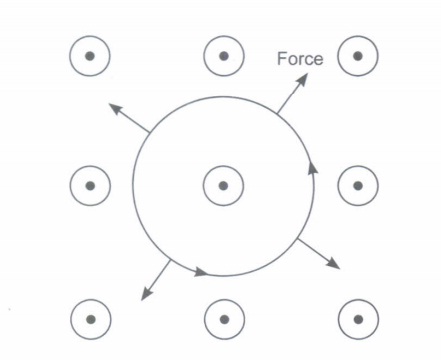
(i) When a current carrying conductor is placed in magnetic field it experiences a force, which is given by \(\overrightarrow{\mathrm{F}}=\mathrm{I} \vec{l} \times \overrightarrow{\mathrm{B}}\) Now consider, a force experienced by a small current element \(\mathrm{I} \overrightarrow{d l}\) of the semicircular wire, which is given by \(d \overrightarrow{\mathrm{F}}=\mathrm{I} \overrightarrow{d l} \times \overrightarrow{\mathrm{B}}\) In uniform magnetic field as \(\overrightarrow{\mathrm{B}}\) = const, then net force experienced by a wire will be given by \(\overrightarrow{\mathrm{F}}=\int \mathrm{I} \overrightarrow{d l} \times \overrightarrow{\mathrm{B}} \quad[\because \mathrm{I}=\mathrm{const}]\) \(\therefore \quad\left|\int \overrightarrow{d l}\right|=\mathrm{AB}=2 \mathrm{R}\) directed from A to B then F = IB2R sin 0° = 0 \(\therefore\) F = 0 (ii) In diagram (b) \(\overrightarrow{\mathrm{AB}} \perp \overrightarrow{\mathrm{B}}, \therefore \theta=90^{\circ}\) \(\therefore\) F = BII sin 90° = BIl, out of the page (iii) In diagram (c) \(\overrightarrow{\mathrm{AB}} \perp \overrightarrow{\mathrm{B}}, \text { i.e. }, \theta=90^{\circ}\) \(\therefore\) F = BIl; and is directed vertically upwards

Related 12th Standard CBSE Physics Materials
12th standard cbse syllabus & materials, 12th maths vector algebra chapter case study question with answers cbse, 12th maths three dimensional geometry chapter case study question with answers cbse, 12th maths probability chapter case study question with answers cbse, 12th maths linear programming chapter case study question with answers cbse, 12th maths differential equations chapter case study question with answers cbse, 12th maths continuity and differentiability chapter case study question with answers cbse, 12th maths application of integrals chapter case study question with answers cbse, 12th chemistry the d and f block elements chapter case study question with answers cbse, 12th chemistry haloalkanes and haloarenes chapter case study question with answers cbse, 12th chemistry coordination compounds chapter case study question with answers cbse, 12th chemistry chemical kinetics chapter case study question with answers cbse, 12th chemistry biomolecules chapter case study question with answers cbse, 12th chemistry amines chapter case study question with answers cbse, 12th aldehydes ketones and carboxylic acids chapter case study question with answers cbse, 12th chemistry alcohols phenols and ethers chapter case study question with answers cbse.

Class VI to XII
Tn state board / cbse, 3000+ q&a's per subject, score high marks.

12th Standard CBSE Study Materials

12th Standard CBSE Subjects

Moving Charges and Magnetism MCQ | Class 12 | Physics | Chapter-4 | 2024
Last updated on July 14th, 2024 at 05:35 pm
Moving Charges and Magnetism MCQ Chapter 2
Magnetism is a phenomenon, which arises from the motion of electric charges and produces magnetic fields.
Below are some of the very important NCERT Moving Charges and Magnetism MCQ Class 12 Physics Chapter 4 with answers. These Moving Charges and Magnetism MCQ have been prepared by expert teachers and subject experts based on the latest syllabus and pattern of CBSE Term 1 examination.
We have given Moving Charges and Magnetism MCQ Class 12 Physics Questions with answers to help students understand the concept.
MCQ Questions for Class 12 Physics are very important for the latest CBSE Term 1 and Term 2 pattern. These MCQs are very important for students who want to score high in CBSE Board, NEET and JEE exam.
We have put together these NCERT MCQ Questions of Moving Charges and Magnetism MCQ for Class 12 Physics Chapter 4 with Answers for the practice on a regular basis to score high in exams. Refer to these MCQs Questions with Answers here along with a detailed explanation.

1 . If we double the radius of a coil keeping the current through it unchanged, what happens to the magnetic field on its axis at very very far away points?
- Halved
- Doubled
- Becomes 4 times
- Remains unchanged
2. An electron and proton enters a magnetic field with equal velocities. Which one of them experiences more force?
- Proton
- Electron
- Both experience same force
- It cannot be predicted
3. Lorentz Force is
- the vector sum of electrostatic and magnetic force acting on a moving charged particle
- the vector sum of gravitational and magnetic force acting on a moving charged particle
- electrostatic force acting on a charged particle
- magnetic force acting on a moving charged particle
4. A proton and a deuterium nucleus having certain kinetic energies enter in a uniform magnetic field with the same component of velocity in the direction of the magnetic field. Which of the following is correct?
- Which particle has greater pitch depends on the fact that which particle has greater component of velocity perpendicular to magnetic field
- Deuterium nucleus has greater pitch of helical motion
- Proton has greater pitch of helical motion
- Both particles have same pitch of helical motion
5. A charged particle moving in a magnetic field experiences a resultant force
- in the direction perpendicular to both the field and its velocity
- in the direction of the field
- in the direction opposite to that of the field
- none of the above
6. Magnetic field can be produced by
- a charge at rest
- a changing electric field
- a moving charge
- both 2 and 3
7. Two electrons move parallel to each other with equal speed ‘v’. The ratio of magnetic and electric forces between them is
- c/v
- c 2 /v 2
8. A charged particle is moving with velocity ‘v’ in a magnetic field of induction B. The force on the particle will be maximum when
- v and B are at angle of 45 degree
- v and B are perpendicular
- v and B are in same direction
- v and B are at opposite directions
9. A charge of 1 coulomb is moving in a magnetic field of 0.5 Tesla with velocity of 10 m/s force experienced is
- 0.5 Newton
- 5 Newton
- 10 Newton
10. A charged particle moving with velocity ‘v’ in a uniform magnetic field B the magnetic force experienced by the particle is
- never 0
- always 0
- 0 if B and v are parallel
- 0 if B and v are perpendicular
11. A charged particle of mass M and charge Q travels on a circular path of radius R that is perpendicular to a magnetic field B. At the time taken by the particle to complete one revolution is
- 2πm / qB
- 2πqB / m
- 2πmq / B
- 2πq 2 B / m
12. Magnetic field due to a ring having n turns at a distance ‘x’ on its axis is proportional to (r = radius of ring)
- r / (x 2 + r 2 )
- nr 2 / (x 2 + r 2 ) 3/2
- r 2 / (x 2 + r 2 ) 3/2
- n 2 r 2 / (x 2 + r 2 ) 3/2
13. Ampere circuital law states that
- the line integral of magnetic field along the boundary of open surface is equal to μ 0 the total current passing near the surface
- the line integral of magnetic field along the boundary of the open surface is equal to μ 0 the total current passing through the surface
- the surface integral of magnetic field over the open surface is equal to μ 0 the total current passing through the surface
- the surface integral of magnetic field over the open surface is equal to μ 0 the total current passing near the surface
14. Magnetic field at any point on the axis of a current element is
- maximum
- minimum
- constant
15. Two thin long parallel wires separated by a distance d carry a current of i A in the same direction. They will
- attract each other with a force of μ 0 i 2 / 2πd
- attract each other with a force of μ 0 i 2 / 2πd 2
- repel each other with a force of μ 0 i 2 / 2πd
- repel each other with a force of μ 0 i 2 / 2πd 2
16. The magnetic induction at any point due to long straight wire carrying a current is
- inversely proportional to the distance from wire
- inversely proportional to the square of the distance from the wire
- does not depend on distance
- proportional to the distance from wire
17. A moving coil sensitive galvanometer gives at once much more deflection. To control its speed of deflection.
- the body of galvanometer should be earthed
- high resistance should be connected across the terminals
- a magnet should be placed near the coil
- a small copper wire should be connected across its terminal
18. If the current is doubled the deflection is also doubled
- in ohmmeter
- a tangent galvanometer
- a moving coil galvanometer
19. Which one of the following is experienced by a current carrying loop in uniform magnetic direction?
- Torque only
- Force only
- Neither talk not force
- Both torque and force
20. A galvanometer having a coil resistance of 60 ohms shows full scale deflection when a current of 1 A passes through it. It can be converted into an ammeter to read current upto 5A by
- putting in series a resistance of 15 ohm
- putting in parallel resistance of 15 ohm
- putting in series a resistance of 240 ohm
- putting in parallel a resistance of 240 ohm
Click Below To Learn Physics Term 1 Syllabus Chapter-Wise MCQs
- Chapter 1: Electric Charges and Fields MCQ
- Chapter 2: Electrostatic Potential MCQ
- Chapter 3: Current Electricity MCQ
- Chapter 4: Moving Charges And Magnetism MCQ
- Chapter 5: Magnetism And Matter MCQ
- Chapter 6: Electromagnetic Induction MCQ
- Chapter 7: Alternating Current MCQ
Click Below To Learn Chemistry Term-1 Syllabus Chapters MCQs
- Chapter-1 : Solid State MCQ
- Chapter-2 : Solution MCQ
- Chapter-7 : P-Block Element MCQ
- Chapter 10 : Haloalkanes and Haloarenes MCQ
- Chapter 11 : Alcohols Phenols and Ether MCQ
- Chapter-14 : Biomolecules MCQ
21. An electron is projected with uniform velocity along the axis of current carrying long solenoid. Which of the following is true?
- The electron will be accelerated along the axis
- The electron path will be circular about the axis
- The electron will experience a force of 45 degree to the axis and hence execute a helical path
- The electron will continue to move with uniform velocity along the axis of the solenoid
22. The Galvanometer cannot as such be used as an ammeter to measure the value of current in a given circuit. The following reasons are
(I) the Galvanometer gives full scale deflection for a small current
(II) Galvanometer has a large resistance
(III) Galvanometer can give inaccurate values
- (I) and (III)
- (I) and (II)
- (II) and (III)
- (I), (II) and (III)
23. A current of 1 A is passed through a straight wire of length 2 m. The magnetic field at a point in air at a distance of 3m from either end of wire and lying on the axis of wire will be
24. A current loop of area A, number of turns N is placed in a uniform magnetic induction B. The angle between the plane of slope and B is θ. The torque acting on the loop will be
25. The strength of the magnetic field at a point R near a long straight current carrying wire is B. the field at a distance R/2 will be
26. A solenoid of length 0.6m has a radius of 2 cm and is made of 600 turns. If it carries a current of 4 A, then the magnitude of magnetic field inside the solenoid is
- 5.024 x 10 -3 T
- 6.024 x 10 -3 T
- 7.024 x 10 -3 T
- 8.024 x 10 -3 T
27. Biot-savart law indicates that the moving electron velocity (v) produce a magnetic field B such that
- It is along the line joining electron and point of observation
- It obeys inverse cube law
28. A milli voltmeter of 25 milli volt range is to be converted into an ammeter of 25 A range. The value of required shunt is
29. A galvanometer of resistance 25Ω is shunted by 2.5Ω resistance. The part of the total current that flows through the galvanometer is given as
- I G /I 0 = 3/11
- I G /I 0 = 1/11
- I G /I 0 = 2/11
- I G /I 0 = 4/11
30. A current carrying loop is placed in a uniform magnetic field. The torque acting on it does not depend on
- Area of loop
- Number of turns
- Shape of loop
- Angle between normal of coil and magnetic field
31. An electron and a proton are moving along the same direction with the same kinetic energy. They enter a uniform magnetic field acting perpendicular to their velocities. The dependence of radius of their path on their masses is
32. A charged particle after being accelerated through a potential difference V enters in a uniform magnetic field and moves in a circle of radius r. If V is doubled, the radius of the circle will become
33. A magnetic field doesn’t exerts any force on
- Stream of electrons
- Stream of protons
- Unmagnetised piece of electron
- Stationary charge
34. A steady electric current is flowing through a cylinder conductor
- The electric field at the axis of the conductor is zero
- The magnetic field at the axis of the conductor is zero
- The magnetic field in the vicinity of the conductor is zero
- None of these
35. What is the shape of a magnet in a moving coil galvanometer to make the radial magnetic field?
- Horse shoe magnet
- Convex
- None of the above
36. Which of the following materials is used in making the core of a moving coil galvanometer?
- Nickel
- Both 1 and 2
37. The gyromagnetic ratio of an electron in sodium atom is
- Depending upon the atomic number of the atom
- Depending upon the shell number of the atom
- Independent of that orbit it is in
- Having positive value
38. A tightly wound 90 turn coil of radius 15 cm has a magnetic field 4 x 10 -4 T at its centre. The current flowing through it is
39. A square frame of side carries i produces a field B at its centre. The same current is passed through a circular coil having the same perimeter as the square. The field at the centre of the circular coil is B’. Find the ratio of (B’/B).
40. A charged particle enters into a space and continues to move undeflected then in that space. Which of the following is true for this case?
- A uniform horizontal electric field and a vertical magnetic field may be present
- A vertical electric field alone may be present
- Uniform electric and magnetic fields, both directed vertically downwards, may be present
- A uniform horizontal magnetic field alone may be present
41. A right angled triangle has one of the angles as 30°. Two magnetic poles are to be kept at the vertices of the triangle. The ratio of the minimum force of interaction to the maximum force of interaction is
42. Two parallel wires carrying current I1 and I2 are separated by distance d. Force per unit length of wire is F. Then
- F ∝ 1 / d 2
43. Two free parallel straight wires carrying currents in opposite direction
- Attract each other
- Do not affect each other
- Repel each other
- Get rotated to be perpendicular to the each other
44. The AC voltage across a resistance can be measured using a
- Moving magnet galvanometer
- Moving coil galvanometer
- Hot wire voltmeter
- Potentiometer
45. The restoring couple in the moving coil galvanometer is because of
- magnetic field
- material of the coil
- twist produced in the suspension (.)
- current in the coil
MCQ Answers
1 . (3) 2. (3) 3. (1) 4. (2) 5. (1) 6. (4) 7. (4) 8. (2) 9. (2) 10. (3) 11. (1) 12. (2) 13. (2) 14. (4) 15. (1) 16. (1) 17. (3) 18. (3) 19. (1) 20. (1) 21. (4) 22. (2) 23. (1) 24. (3) 25. (1) 26. (1) 27. (1) 28. (1) 29. (2) 30. (3) 31. (1) 32. (4) 33. (4) 34. (2) 35. (1) 36. (3) 37. (3) 38. (1) 39. (4) 40. (4) 41. (1) 42. (2) 43. (3) 44. (3) 45. (3)

Assertion-Reasoning Based MCQ
- If both assertion and reason are true and reason is the correct explanation of assertion.
- If both assertion and reason are true, but reason is not the correct explanation of assertion.
- If the assertion is true, but the reason is false.
- If the assertion is false, but the reason is true.
1 . Assertion When a test charge moves through the magnetic field, its momentum changes but kinetic energy remains same.
Reason The magnetic force acts as a centripetal force, which is perpendicular to the instantaneous velocity and so does no work.
2. Assertion Magnetic field interacts with a moving charge.
Reason A moving charge produces a magnetic field.
3. Assertion Free electron always keeps on moving in a conductor even then no magnetic force act on them in magnetic field unless a current is passed through it.
Reason The average velocity of free electron is zero.
4. Assertion Two beam of electrons traveling in the same direction repel each other.
Reason The electrostatic interaction is less than the magnetic interaction.
5. Assertion If the current in a solenoid is reversed in direction while keeping the same magnitude, the magnetic field energy stored in the solenoid decreases.
Reason Magnetic field energy density is proportional to square of current.
6. Assertion The magnetic field produced by a current carrying solenoid is independent of its length and cross-sectional area.
Reason The magnetic field inside the solenoid is uniform.
7. Assertion If two long wire, hanging freely an connected to a battery in series, they come closer to each other.
Reason Force of attraction acts between the two wires carrying current.
8. Assertion In a shunted galvanometer only 10% current passes through the galvanometer. The resistance of the galvanometer is G. Then resistance of the shunt in G/9.
Reason If S is the resistance of the shunt, then voltage across S and G is same.
9. Assertion To convert a galvanometer into an ammeter a small resistance is connected in parallel with it.
Reason The small resistance increases the combined resistance of the combination.
10. Assertion An ammeter is always connected in series whereas a voltmeter is connected in parallel.
Reason An ammeter is a low resistance galvanometer while a voltmeter is high resistance galvanometer.
Assertion-Reasoning MCQ Answers
Kinetic energy of the charged particle remains same in the circular path while velocity and momentum of the particle changes because of continous change in the direction of motion.
A moving charge experience a force in magnetic field. It is because of interaction of two magnetic fields, one which is produced due to the motion of charge and other in which charge is moving.
In the absence of electric field, the free electron in a conductor are in a state of random motion, like molecules in a gas. Their average velocity is zero, i.e, they do not have any net magnetic force on the free electrons in the magnetic field. On passing the current, the free electrons acquire drift velocity in a definite direction, hence magnetic force acts on them, unless the field has no perpendicular component.
Two beams of electron traveling in the same direction repel each other because the electrostatic interaction is more that the magnetic interaction.
Reversing the direction of the current reverses the direction of magnetic field. However, it has no effect on the magnetic field energy density, which is proportional to the square of the magnitude interaction.
The earth’s magnetic field is towards north and the velocity of electron is vertically downward. Applying Fleming’s left hand rule, the direction of force is towards west. Therefore, an electron coming from outer space will be deflected toward west.
When two long parallel wires, are connected to a battery in series. They carry current in opposite directions, hence they repel each other.
IgG = (I-Ig)S
S = (Ig / I – Ig) G
Ig = I / 10
An ammeter should have a low resistance which we get when we connect low resistance in parallel with galvanometer.
An ammeter is a low resistance device and is connected in series so as the whole circuit current flows through it for an accurate measurement. A voltmeter is a device having a high resistance. So, if we connect it in series, it would hinder the current flow in the circuit hence open circuit results.
Case Study Based MCQ
1 . A charged particle enters into a uniform magnetic field and follows a circular path as shown. This happens when the particle enters perpendicular to the magnetic field. It gets deflected by magnetic Lorentz force arrows indicate the direction of motion of the charged particle.
If V the velocity of the particle of charge q and B is the magnetic field, then the force acting on the particle is given by: F = q ( v X B )
In the particle velocity is perpendicular to the magnetic field, then the magnetic of the force is F = qvB. This force provides the necessary centripetal force for the particle and the radius of the circular path is given by
r = mv / qB
The direction of deflection also depends on the nature of the charge. If the particle enters the fields at an angle other than 90°, then, the path of the particle will be helical.
(i) Which of the following particles will not get affected if sent into a magnetic field normal to it?
(b) Positron
(c) Neutron
(d) Electron
(ii) When a proton and an electron enter a magnetic field normal to it, which of the following statements is correct (Assume that their speeds are equal)?
(a) They will get deflected in opposite directions
(b) Radius of circular path of electron will be less
(c) Radius of circular path of proton will be less
(d) Both (a) and (b)
(iii) A deutron enters a magnetic field parallel to it. Its path inside the field will be
(a) a straight line
(d) parabola
(iv) If a proton, a deuteron and an alpha particle are projected into a magnetic field perpendicular to it with the same speed, which of them will have the path of highest radius?
(b) Deuteron
(c) Alpha particle
(d) Both (b) and (C)
(v) An electron enters a magnetic field making an angle of 45° with it. The path of the electron will be
(a) Straight line
(d) Parabola
2. Biot Savart law was given by Biot and Savart after doing many experiments. This law is related with the magnetic field induced at any point due to a small current carrying element. According to the law, the magnetic field induced at a point near the current carrying element is directly proportional to the current flowing in the conductor, length of the element, sinፀ and inversely proportional to the square of the distance of point from the element.
(i) Biot Savart law was given by
(a) Oersted
(c) Biot and Savart
(d) Maxwell
(ii) Biot Savart law is related with the ______ induced at a point near current carrying element.
(a) Magnetic field
(b) Gravitational field
(c) Electric field
(d) None of these
(iii) Induced magnetic field is directly proportional to
(d) All of these
(iv) The magnetic field induced at a point is inversely proportional to
(d) 1 / r 2
(v) As the distance between the point and current carrying element decreases, dB
(a) increases
(b) decreases
(c) remains same
(d) both (a) and (b)
3. In certain polar regions of splendid display of colours is seen in the sky. The appearance of dancing green pink light is fascinating and equally puzzling.
Consider a charged particle for mass M and charge Q enters a region of magnetic field B with an initial velocity V. Let this velocity have a component Vp parallel to the magnetic field and a component Vn normal to it. There is no force on a charged particle in the direction of field. Hence the particle continue to travel with the velocity Vp parallel to the field.
The normal component Vn of the particle results in a Lorentz Force which is perpendicular to both and the particle does has a tendency to perform a circular motion in a plane perpendicular to the magnetic field. When this is coupled with the velocity parallel to the field, the resulting trajectory will be a helix along the magnetic field line. Even if the field line bends, the helically moving particle is trapped and guided to move around the field line.
Since the Lorentz Force is normal to the velocity of each point, the field does not work on the particle and the magnitude of the velocity remains the same. During a solar flare, a large number of electrons and protons are rejected from the sun. Some of the get trapped in the Earth’s magnetic field and move in a helical path along the field line.
The field lines come closer to each other near the magnetic poles. Hence, the density of charges increases near the poles. These particles collide with atoms and molecules of the atmosphere. Excited oxygen atoms emit green light an excited nitrogen atoms emit pink light. This phenomenon is called Aurora Borealis in physical science.
(i) Which of the following defines the exact meaning of magnetic field?
(a) Magnetic field is a scalar field that describes the magnetic influence on moving electric charges, electric currents and magnetic materials.
(b) Magnetic field is a vector field that describes the magnetic influence on moving electric charges, electric currents, and magnetic materials.
(c) Both scalar and vector fields that describe the magnetic influence on moving electric charges, electric currents, and magnetic materials.
(d) Magnetic field is a vector field that describes the magnetic influence on static electric charges, electric currents, and magnetic materials.
(ii) Which of the following defines the exact meaning of Lorentz Force the Lorentz force?
(a) The Lorentz force is the combination of electric and magnetic field force on a point charge due to electromagnetic fields
(b) the Lorentz Force is a combination of electric and magnetic force on a point charge due to gravitational field
(c) the Lorentz Force is a combination of gravitational force and magnetic force on a point charge due to electromagnetic field
(d) the Lorentz Force is the combination of electric and centripetal force on the point charge due to electromagnetic fields
(iii) Which of the following defines the exact meaning of circular motion?
(a) Circular motion is apparent outward force on mass with when it is rotated
(b) Circular motion vector field that describes the magnetic influence on moving electric charges electric currents, and magnetic materials
(c) Circular motion in an object is the rate of change of its position with respect to a frame of reference, and is a function of time
(d) Circular motion is a movement of an object along the circumference of a circle or rotation along a circular path
(iv) What does Aurora Borealis mean?
(a) The Aurora Borealis otherwise known as northern lights, is a physics phenomenon that can be magical to observe, striking onlookers to wonder about the cause of the whimsical light that dance overhead.
(b) The Aurora Borealis otherwise known as southern lights, is a physics phenomenon that can be magical to observe, striking onlookers to wander about the cause of the whimsical life that downs overhead
(c) The Aurora Borealis otherwise known as the Eastern lights, is a physics phenomenon that can be magical to observe, striking onlookers to wander about the cause of the whimsical lies that dance overhead
(d) The Aurora Borealis is a apparent outward force on the mass when it is rotated
(v) Consider a tightly wound 100 turn coil of radius 10cm carrying a current of 1A. What is the magnitude of magnetic field at the centre of the coil?
(a) 2.28 x 10 -4 T
(b) 6.28 x 10 -4 T
(c) 3.28 x 10 -4 T
(d) 5.28 x 10 -4 T
Case Study Based MCQ Answers
1 . (i) (c) Neutron particles are not affected by magnetic field.
(ii) (d) Opposite deflection because of opposite charge. Lighter particles get deflected more.
(iii) (a) Straight line
(iv) (d) r is proportional to m/q
(v) (c) Helix
2. (i) (c) Biot and Savart
(ii) (a) Magnetic field
(iii) (d) All of these
(iv) (a) r 2
(v) (a) Increase, dB is inversely proportional to r 2
3. (i) (b) The exact meaning of magnetic field is a vector field that describes the magnetic influence on moving electric charges, electric currents, and magnetic materials.
(ii) (a) The Lorentz force is the combination of electron and magnetic force on a point charge due to electromagnetic fields. A particle of charge q moving with a velocity v in an electric field E and a magnetic field B experiences a force of F = qE + qvB.
(iii) (d) Circular motion is a movement of an object along the circumstances of a circle or rotation along a circular path. It can be uniform, with constant angular rate of rotation and constant speed, or non-uniform with a changing rate of rotation. The rotation around a fixed axis of a 3-D body involves circular motion of its parts.
(iv) (a) The Aurora Borealis otherwise known as northern lights, is a physics phenomenon that can be magical to observe, striking onlookers to wonder about the cause of the whimsical light that dance overhead. This extraordinary display is caused by charged particles being expelled into space from the sun.
(v) (b) B = μ 0 NI / 2R = (4π x 10 -7 x 10 2 x 1) / (2 x 10 -1 ) = 2π x 10 -4 = 6.28 x 10 -4 T
Final Words
From the above article, you have practiced Moving Charges and Magnetism MCQ of Class 12 Physics Chapter 4. We hope that the above mentioned latest Moving Charges and Magnetism for Term 1 of Chapter 4 will surely help you in your exam.
If you have any doubts or queries regarding the Moving Charges and Magnetism MCQ with Answers of CBSE Class 12 Physics, feel free to reach us and we will get back to you as early as possible.
Click Below To Learn Physical Education Term-1 Syllabus Chapters MCQs
- Chapter 1 : Planning in sports MCQ
- Chapter 2 : Sports And Nutrition MCQ
- Chapter 5 : Children and Women in Sports MCQ
- Chapter 6 : Test and Measurement in Sports MCQ
- Chapter 8 : Biomechanics and Sports MCQ
The Site is down as we are performing important server maintenance, during which time the server will be unavailable for approximately 24 hours. Please hold off on any critical actions until we are finished. As always your feedback is appreciated.

- Study Packages
- NCERT Solutions
- Sample Papers
- Online Test

- Questions Bank
- Test Series
- Ncert Solutions
- Solved Papers
- Current Affairs
- JEE Main & Advanced
- Pre-Primary
- MP State Exams
- UP State Exams
- Rajasthan State Exams
- Jharkhand State Exams
- Chhattisgarh State Exams
- Bihar State Exams
- Haryana State Exams
- Gujarat State Exams
- MH State Exams
- Himachal State Exams
- Delhi State Exams
- Uttarakhand State Exams
- Punjab State Exams
- J&K State Exams
12th Class Physics Magnetism Question Bank
Done case based (mcqs) - moving charges and magnetism total questions - 50.
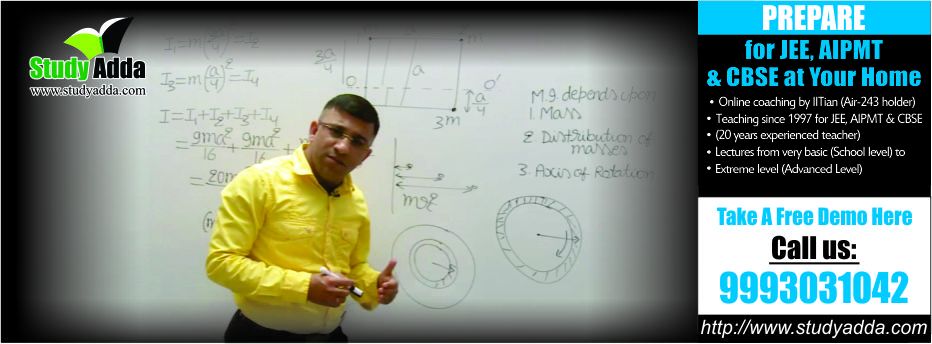
| Direction: Q.1 to Q.5 |
| In 1820, A Danish physicist, Hans Christian Oersted, discovered that there is a relationship between electricity and magnetism. By setting up a compass through a wire carrying an electric current. Oersted showed that moving electrons can create a magnetic field. Oersted found that, for a straight wire carrying a steady current (DC), the magnetic field lines encircle the current-carrying wire. The magnetic field lines lie in a plane perpendicular to the wire. If the direction of the current is reversed, the direction of the magnetic force reverses. The strength of the field is directly proportional to the magnitude of the current. The strength of the field at any point is inversely proportional to the distance of the point from the wire. |
| Read the given passage carefully and give the answer of the following questions. |
A) H.C. Oersted done clear
B) Charles William Oersted done clear
C) Charles Maxwell done clear
D) Andre Marie Ampere done clear
question_answer 2) If magnitude of the current in the wire increases, strength of magnetid field:
A) increases done clear
B) decreases done clear
C) remains unchanged done clear
D) None of these done clear
question_answer 3) Which of the following statements is true?
A) There is no relationship between electricity and magnetism done clear
B) An electric current produces a magnetid field done clear
C) A compass is not affected by electricity done clear
D) A compass is not affected by a magnet done clear
question_answer 4) A compass needle is placed below a straight conducting wire. If current is passing through the conducting wire from north to south, then the deflection of the compass is:
A) towards west done clear
B) towards east done clear
C) keeps oscillating in east-west direction done clear
D) no deflection done clear
question_answer 5) Charges at rest can produce:
A) static electric field done clear
B) magnetic field done clear
C) induced current done clear
D) conventional current done clear
| Direction: Q.6 to Q.10 |
| A charged particle moving in a magnetic field experiences a force that is proportional to the strength of the magnetic field, the component of the velocity that is perpendicular to the magnetic field and the charge of the particle. |
| This force is given by \[\overrightarrow{F}=q(\overrightarrow{v}\times \overrightarrow{B})\]where q is the electric charge of the particle, v is the instantaneous velocity of the particle, and B is the magnetic field (in Tesla). |
| The direction of force is determined by the rules of cross product of two vectors. |
| Force is perpendicular to both velocity and magnetic field. |
| Its direction is same as \[\overrightarrow{v}\times \overrightarrow{B}\] if q is positive and opposite to \[\overrightarrow{v}\times \overrightarrow{B}\] if q is negative. |
| The force is always perpendicular to both the velocity of the particle and the magnetic field that created it. Because the magnetic force is always perpendicular to the motion, the magnetic field can do no work on an isolated charge. It can only do work indirectly, via the electric field. generated by a changing magnetic field. |
| Read the given passage carefully and give the answer of the following questions. |
A) remains stationary done clear
B) spins about its own axis done clear
C) moves in the direction of the field done clear
D) moves perpendicular to the direction of the field. done clear
question_answer 7) A proton is projected with a uniform velocity v along the axis of a current carrying solenoid, then:
A) the proton will be accelerated along the axis done clear
B) the proton path will be circular about the axis done clear
C) the proton moves along helical path done clear
D) the proton will continue to move with velocity v along the axis. done clear
question_answer 8) A charged particle experiences magnetic force in the presence of magnetic field. Which of the following statement is correct?
A) The particle is stationary and magnetid field is perpendicular. done clear
B) The particle is moving and magnetic field is perpendicular to the velocity. done clear
C) The particle is stationary and magnetic field is parallel. done clear
D) The particle is moving and magnetic field is parallel to velocity. done clear
question_answer 9) A charge q moves with a velocity \[2\text{ }m{{s}^{-1}}\] along X-axis in a uniform magnetic field\[\overrightarrow{B}=(\widehat{i}+2\widehat{j}+3\widehat{k})T\], then charge will experience a force:
A) in ZY-plane done clear
B) along -Y axis done clear
C) along + Z axis done clear
D) along-Z axis done clear
question_answer 10) Moving charge will produce:
A) electric field only done clear
B) magnetic field only done clear
C) both electric and magnetic field done clear
D) None of the above done clear
| Direction: Q.11 to Q.15 |
| An electron with speed \[{{v}_{0}}<<c\]moves in a circle of radius \[{{r}_{0}}\] in a uniform magnetic field, |
| This electron is able to traverse a circular path as magnetic field is perpendicular to the velocity of the electron. A force acts on the particle perpendicular to both \[\overrightarrow{{{v}_{0}}}\] and \[\overrightarrow{B}\]. This force continuously deflects the particle sideways without changing its speed and the particle will move along a circle perpendicular to the field. The time required for one revolution of the electron is \[{{T}_{0}}\] . |
| Read the given passage carefully and give the answer of the following questions. |
A) \[4{{r}_{0}}\] done clear
B) \[2{{r}_{0}}\] done clear
C) \[{{r}_{0}}\] done clear
D) \[{{r}_{0}}/2\] done clear
question_answer 12) If \[v=2{{v}_{0}}\], then the time required for one revolution of the electron will change to:
A) \[4{{T}_{0}}\] done clear
B) \[2{{T}_{0}}\] done clear
C) \[{{T}_{0}}\] done clear
D) \[{{T}_{0}}/2\] done clear
question_answer 13) A charged particle is projected in a magnetic field\[\overrightarrow{B}=(2\widehat{i}+4\widehat{j})\times {{10}^{2}}T\]. The acceleration of the particle is found to be \[\overrightarrow{a}=(x\widehat{i}+2\widehat{j})m{{s}^{-2}}\]. Find the value of x.
A) \[4\,m{{s}^{-2}}\] done clear
B) \[-4\,m{{s}^{-2}}\] done clear
C) \[-2\,m{{s}^{-2}}\] done clear
D) \[2\,m{{s}^{-2}}\] done clear
question_answer 14) If the given electron has a velocity not perpendicular to B, then trajectory of the electron is:
A) straight line done clear
B) circular done clear
C) helical done clear
D) zig-zag done clear
question_answer 15) If this electron of charge (e) is moving parallel to uniform magnetic field with constant velocity v. the force acting on the electron is:
A) Bev done clear
B) \[\frac{Be}{v}\] done clear
C) \[\frac{B}{ev}\] done clear
D) zero done clear
| Direction: Q.16 to Q.20 |
| The path of a charged particle in magnetic field depends upon angle between velocity and magnetic field. |
| If velocity \[\overrightarrow{v}\] is at angle \[\theta \] to \[\overrightarrow{B}\], component of velocity parallel to magnetic field \[(v\,cos\,\theta )\] is responsible for circular motion, thus the charge particle moves in a helical path. . |
| The plane of the circle is perpendicular to the magnetic field and the axis of the helix is parallel to the magnetic field. The charged particle moves along helical path touching the line parallel to the magnetic field passing through the starting point after each rotation. |
| Radius of circular path is \[r=\frac{mv\,\sin \theta }{qB}\] |
| Hence the resultant path of the charged particle will be a helix, with its axis along the direction of \[\overrightarrow{B}\] as shown in figure. |
| Read the given passage carefully and give the answer of the following questions. |
A) (i) only done clear
B) (i) or (ii) done clear
C) (i) or (iii) done clear
D) any one of (i) (ii) and (iii) done clear
question_answer 17) Two charged particles A and B having the same charge, mass and speed enter into a magnetic field in such a way that the initial path of A makes an angle of \[30{}^\circ \] and that of B makes an angle of \[90{}^\circ \] with the field. Then the trajectory of:
A) B will have smaller radius of curvature than that of A done clear
B) both will have the same curvature done clear
C) A will have smaller radius of curvature than that of B done clear
D) both will move along the direction of their original velocities. done clear
question_answer 18) An electron having momentum \[2.4\times {{10}^{-23}}kg\text{ }m/s\]enters a region of uniform magnetic field of 0.15 T. The field vector makes an angle of \[30{}^\circ \] with the initial velocity vector of the electron. The radius of the helical path of the electron in the field shall be:
A) 2 mm done clear
B) 1mm done clear
C) \[\frac{\sqrt{3}}{2}mm\] done clear
D) 0.5 mm done clear
question_answer 19) The magnetic field in a certain region of space is given by \[\overrightarrow{B}=8.35\times {{10}^{-2}}\widehat{i}\,\,T\]. A proton shot into the field with velocity \[\overrightarrow{v}=(2\times {{10}^{5}}\widehat{i}+4\times {{10}^{2}}\widehat{j})m/s\]. The proton follows a helical path in the field. The distance moved by proton in the x-direction during the period of one revolution in the yz-plane will be (Mass proton \[=1.67\times {{10}^{-27}}kg\]):
A) 0.053 m done clear
B) 0.136 m done clear
C) 0.157 m done clear
D) 0.236 m done clear
question_answer 20) The frequency of revolution of the particle is:
A) \[\frac{m}{qB}\] done clear
B) \[\frac{qB}{2\pi m}\] done clear
C) \[\frac{2\pi R}{v\,\cos \theta }\] done clear
D) \[\frac{2\pi R}{v\,sin\theta }\] done clear
| Direction: Q.21 to Q.25 |
| A magnetic field can be produced by moving, charges or electric currents. The basic equation governing the magnetic field due to a current distribution is the Biot-Savart law. |
| Finding the magnetic field resulting from a current distribution involves the vector product, and is inherently a calculus problem when the distance from the current to the field point is continuously chaning. |
| According to this law, the magnetic field at a point due to a current element of length \[d\,\overrightarrow{l}\] carrying current I, at a distance r from the element is \[dB=\frac{{{\mu }_{0}}}{4\pi }\frac{I(d\,\overrightarrow{l}\times \overrightarrow{r})}{{{r}^{3}}}\]. |
| Biot-Savart law has certain similarities as well as difference with Coloumb's law for electrostatic field e. g., there is an angle dependence in Biot-Savart law which is not present in electrostatic case. |
| Read the given passage carefully and give the answer of the following questions. |
A) of position vector \[\overrightarrow{r}\] of the point done clear
B) of current element \[d\text{ }\overrightarrow{l}\] done clear
C) perpendicular to both \[d\text{ }\overrightarrow{\text{l}}\] and \[\overrightarrow{r}\] done clear
D) perpendicular to \[d\text{ }\overrightarrow{\text{l}}\] only done clear
question_answer 22) The magnetic field due to a current in a straight wire segment of length L at a point on its perpendicular bisector at a distance r (r > > L):
A) decreasea as \[\frac{1}{r}\] done clear
B) decreases as \[\frac{1}{{{r}^{2}}}\] done clear
C) decreases as \[\frac{1}{{{r}^{3}}}\] done clear
D) approaches a finite limit as \[r\to \infty \] done clear

A) \[{{\mu }_{0}}i/r\] done clear
B) \[4{{\mu }_{0}}i/r\] done clear
C) zero done clear
D) \[{{\mu }_{0}}i/4r\] done clear
question_answer 24) A long straight wire carries a current along the z-axis for any two points in the x-y plane. Which of the following is always false?
A) The magnetic fields are equal done clear
B) The directions of the magnetic fields are the same done clear
C) The magnitudes of the magnetic fields are equal done clear
D) The field at one point is opposite to that at the other point done clear
question_answer 25) Biot-Savart law can be expressed alternatively as:
A) Coulomb's Law done clear
B) Ampere's circuital law done clear
C) Ohm's Law done clear
D) Gauss's Law done clear
| Direction: Q.26 to Q.30 |
| Ampere's law gives a method to calculate the magnetic field due to given current distribution. According to it, the circulation \[\oint{\overrightarrow{B}\cdot d\,\overrightarrow{l}}\] of the resultant magnetic field along a |
| closed plane curve is equal to \[{{\mu }_{0}}\] times the total current crossing the area bounded by the closed curve provided the electric field inside the loop remains constant. Ampere's law is more useful under certain symmetrical conditions. Consider one such case of a long straight wire with circular cross-section (radius R) carrying current I uniformly distributed across this cross-section. |
| Read the given passage carefully and give the answer of the following questions. |
A) \[\frac{{{\mu }_{0}}l}{2\pi r}\] done clear
B) \[\frac{{{\mu }_{0}}l}{2\pi R}\] done clear
C) \[\frac{{{\mu }_{0}}l{{R}^{2}}}{2\pi r}\] done clear
D) \[\frac{{{\mu }_{0}}l{{r}^{2}}}{2\pi R}\] done clear
question_answer 27) The magnetic field at a distance r in the region r<R is:
A) \[\frac{{{\mu }_{0}}l}{2\pi }\] done clear
B) \[\frac{{{\mu }_{0}}l{{r}^{2}}}{2\pi {{R}^{2}}}\] done clear
C) \[\frac{{{\mu }_{0}}l}{2\pi r}\] done clear
D) \[\frac{{{\mu }_{0}}lr}{2\pi {{R}^{2}}}\] done clear
question_answer 28) A long straight wire of a circular cross section (radius a) carries a steady current l and the current l is uniformly distributed across this cross-section. Which of the following plots represents the variation of magnitude of magnetic field B with distance r from the centre of the wire?

question_answer 29) A long straight wire of radius R carries a steady current l. The current is uniformly distributed across its cross-section. The ratio of magnetic field at R/2 and 2R is:
A) \[\frac{1}{2}\] done clear
B) 2 done clear
C) \[\frac{1}{4}\] done clear
D) 1 done clear
question_answer 30) A direct current l flows along the length of an infinitely long straight thin walled pipe, then the magnetic field is:
A) uniform throughout the pipe but not zero done clear
B) zero only along the axis of the pipe done clear
C) zero at any point inside the pipe done clear
D) maximum at the centre and minimum at the edges. done clear
| Direction: Q.31 to Q.35 |
| As shown in figure a solenoid where the wire is coiled around a cylinder, each wire loop in this coil acts as if it was a separate circular wire carrying the same current l, the current in the coiled wire and the dense enough array of such loops may be approximated by a cylindrical current sheet with the current density. |
| \[J=I\times (N/L)=I\times L\,\,(loops/solenoid\,\,length)\] |
| For simplicity, let's assume a long solenoid (length >> diameter) which we approximate as infinitely long. For a long solenoid (compared to its diameter), the magnetic field inside the solenoid is approximately uniform and approximately parallel to the axis, except near the ends of the solenoid. Outside the solenoid, the magnetic field looks like the field of a physical dipole, with the north pole at one end of the solenoid and the south pole at the other end and is approximately negligible. |
| Read the given passage carefully and give the answer of the following questions. |
A) Plastic done clear
B) Glass done clear
C) Quartz done clear
D) Copper done clear
question_answer 32) The magnetic field inside the solenoid is:
A) non-uniform and parallel to the axis done clear
B) uniform and parallel to the axis done clear
C) non-uniform and perpendicular to the axis done clear
D) uniform and perpendicular to the axis done clear
question_answer 33) A proton is moving from left to right direction and outside the solenoid, then what is the direction of force on the proton?
A) Upwards done clear
B) Downwards done clear
C) Proton will not deflect done clear
D) Inwards done clear
question_answer 34) How the magnetic field inside the solenoid depends upon the number of turns?
A) Inversely proportional done clear
B) Directly proportional done clear
C) Proportional to the number of turns done clear
D) None of the above done clear
question_answer 35) Direction of magnetic field in a solenoid can be determined by:
A) Ohm's Law done clear
B) Fleming's left-hand rule done clear
C) Ampere's right-hand rule done clear
D) Biot-Savart's Law done clear
| Direction: Q.36 to Q.40 |
| A solenoid is a long coil of wire tightly wound in the helical form. Solenoid consists of closely stacked rings electrically insulated from each other wrapped around a non-conducting cylinder. |
| Figure below shows the magnetic field lines of a solenoid carrying a steady current I. We see that if the turns are closely spaced, the resulting magnetic field inside the solenoid becomes fairly uniform, provided that the length of the solenoid is much greater than its diameter. For an "ideal" solenoid, which is infinitely long with turns thighly packed, the magnetic field inside the solenoid is uniform and parallel to the axis, and vanishes outside the solenoid. |
| Read the given passage carefully and give the answer of the following questions. |
A) \[16\times {{10}^{-4}}T\] done clear
B) \[8\times {{10}^{-4}}T\] done clear
C) \[32\times {{10}^{-4}}T\] done clear
D) \[4\times {{10}^{-4}}T\] done clear
question_answer 37) Choose the correct statement in the following:
A) The magnetic field inside the solenoid is less than that of outside done clear
B) The magnetic field inside an ideal solenoid is not at all uniform done clear
C) The magnetic field at the centre, inside an ideal solenoid is almost twice that at the ends done clear
D) The magnetic field at the centre, inside an ideal solenoid is almost half of that at the ends done clear
question_answer 38) The magnetic field (B) inside a Long solenoid having n turns per unit length and carrying current l when iron core is kept in it is (\[{{\mu }_{0}}\] = permeability of vacuum, \[\chi \] = magnetic susceptibility):
A) \[{{\mu }_{0}}nl(1-\chi )\] done clear
B) \[{{\mu }_{0}}nl\,\chi \] done clear
C) \[{{\mu }_{0}}n{{l}^{2}}(1+\chi )\] done clear
D) \[{{\mu }_{0}}nl(1+\chi )\] done clear
question_answer 39) A solenoid of length l and having n turns carries a current l is in anticlockwise direction. The magnetic field is:
A) \[{{\mu }_{0}}nl\] done clear
B) \[{{\mu }_{0}}\frac{nl}{{{l}^{2}}}\] done clear
C) along the axis of solenoid done clear
D) perpendicular to the axis of coil done clear
question_answer 40) The magnitude of the magnetic field inside a long solenoid is increased by:
A) decreasing its radius done clear
B) decreasing the current through it done clear
C) increasing its area of cross-section done clear
D) introducing a medium of higher permeability done clear
| Direction: Q.41 to Q.45 |
| When a rectangular loop PQRS of sides 'a' and 'b carrying current I is placed in uniform magnetic |
| field \[\overrightarrow{B}\], such that area vector \[\overrightarrow{A}\] makes an angle \[\theta \] with direction of magnetic field, then forces on the arms QR and SP of loop are equal, opposite and collinear, thereby perfectly cancel each other, whereas forces on the arms PQ and RS of loop are equal and opposite but not collinear, so they give rise to torque on the loop. |
| Force on side PQ or RS of loop is \[F=lbB\,\sin \,90{}^\circ =lbB\] and perpendicular distance between two non-collinear forces is \[{{r}_{\bot }}=a\,\sin \,\theta \] |
| So, torque on the loop, \[\tau =JAB\,\sin \theta \] |
| In vector form, torque \[\tau =\overrightarrow{M}\times \overrightarrow{B}\] |
| where \[\overrightarrow{M}\times NI\,\overrightarrow{A}\] is called magnetic dipole moment of current loop and is directed in direction of area vector \[\overrightarrow{A}\] i.e., normal to the plane of loop. |
| Read the given passage carefully and give the answer of the following questions. |
A) zero done clear
B) \[{{10}^{-4}}Nm\] done clear
C) \[~{{10}^{-2}}Nm\] done clear
D) 1 N m done clear
question_answer 42) Relation between magnetic moment and angular velocity is:
A) \[M\propto \omega \] done clear
B) \[M\propto {{\omega }^{2}}\] done clear
C) \[M\propto \sqrt{\omega }\] done clear
D) None of these done clear
question_answer 43) A current Loop in a magnetic field:
A) can be a equilibrium in two orientations, both the equilibrium states are unstable done clear
B) can be in equilibrium in two orientations, one stable while the other is unstable done clear
C) experiences a torque whether the field is uniform or non uniform in all orientations done clear
D) can be in equilibrium in one orientation done clear
question_answer 44) Q.4. The magnetic moment of a current l carrying circular coil of radius r and number of turns N varies as:
A) \[\frac{1}{{{r}^{2}}}\] done clear
B) \[\frac{1}{r}\] done clear
C) r done clear
D) \[{{r}^{2}}\] done clear
question_answer 45) A rectangular coil carrying current is placed in a non-uniform magnetic field. On that coil the total:
A) force is non-zero done clear
B) force is zero done clear
C) torque is zero done clear
D) None of these done clear
| Direction: Q.46 to Q.50 |
| Moving coil galvanometer operates on Permanent Magnet Moving Coil (PMMC) mechanism and was designed by the scientist D'arsonval. |
| Moving coil galvanometers are of two types: |
| (i) Suspended coil |
| (ii) Pivoted coil type or tangent galvanometer. |
| Its working is based on the fact that when a current carrying coil is placed in a magnetic field, it experiences a torque. This torque tends to rotate the coil about its axis of suspension in such a way that the magnetic flux passing through the coil is maximum. |
| Read the given passage carefully and give the answer of the following questions. |
A) is used to measure emf done clear
B) is used to measure potential difference done clear
C) is used to measure resistance done clear
D) is a deflection instrument which gives a deflection when a current flows through its coil done clear
question_answer 47) To make the field radial in a moving coil galvanometer.
A) number of turns of coil is kept small done clear
B) magnet is taken in the form of horse-shoe done clear
C) poles are of very strong magnets done clear
D) poles are cylindrically cut done clear
question_answer 48) The deflection in a moving coil galvanometer is:
A) directly proportional to torsional constant of spring done clear
B) directly proportional to the number of turns in the coil done clear
C) inversely proportional to the area of the coil done clear
D) inversely proportional to the current in the coil done clear
question_answer 49) In a moving coil galvanometer, having a coil of N-turns of area A and carrying current l is placed in a radial field of strength B.
A) \[N{{A}^{2}}{{B}^{2}}l\] done clear
B) \[NAB{{l}^{2}}\] done clear
C) \[{{N}^{2}}ABl\] done clear
D) \[NABl\] done clear
question_answer 50) To increase the current sensitivity of a moving coil galvanometer, we should decrease:
A) (a) strength of magnet done clear
B) (b) torsional constant of spring done clear
C) number of turns in coil done clear
D) area of coil done clear
Study Package

Case Based (MCQs) - Moving Charges and Magnetism
Related question.

Reset Password.
OTP has been sent to your mobile number and is valid for one hour
Mobile Number Verified
Your mobile number is verified.

Class 12 Physics Assertion Reason Questions Chapter 4 Moving Charges And Magnetism
- Post author: studyrate
- Post published:
- Post category: 12 board / Class 12
- Post comments: 0 Comments
Download the chapter on Moving Charges And Magnetism from the CBSE Class 12 Physics Assertion Reason Questions. Class 12 Physics Assertion Reason Questions with Answers were created using the most recent exam format. To gauge their degree of preparedness, students can complete the NCERT Class 12 Physics Chapter 4 Moving Charges And Magnetism.
Join our Telegram Channel, there you will get various e-books for CBSE 2024 Boards exams for Class 9th, 10th, 11th, and 12th.

Moving Charges And Magnetism Class 12 Assertion Reason Questions
The following questions consist of two statements – Assertion (A) and Reason (R). Answer these questions by selecting the appropriate option given below: (a) Both A and R are true and R is the correct explanation of A. (b) Both A and R are true but R is not the correct explanation of A. (c) A is true but R is false. (d) A is false and R is also false.
Assertion (A): A charged particle experiences a force when moving through a magnetic field. Reason (R): The force on a charged particle in a magnetic field is given by the equation F = q(v × B), where q is the charge, v is the velocity of the particle, and B is the magnetic field.
Answer: (a) Both A and R are true and R is the correct explanation of A.
Assertion (A): The force on a charged particle due to a magnetic field is always perpendicular to both the velocity of the particle and the direction of the magnetic field. Reason (R): The force experienced by a charged particle moving in a magnetic field follows the right-hand rule, where the force is perpendicular to both v and B.
Assertion (A): The magnetic force on a charged particle is zero when the particle moves parallel to the magnetic field. Reason (R): The cross product of two parallel vectors is zero, and hence the force on a charged particle moving parallel to the magnetic field is zero.
Answer: (c) A is true but R is false.
Assertion (A): The magnetic force on a charged particle is maximum when the particle moves perpendicular to the magnetic field. Reason (R): When the charged particle moves perpendicular to the magnetic field, the sine of the angle between v and B is maximum, resulting in the maximum magnetic force.
Assertion (A): A magnetic field can change the speed of a charged particle. Reason (R): A magnetic field exerts a force on a charged particle, which can change the direction of its velocity, but not its speed.
Assertion (A): Magnetic field lines are continuous closed loops. Reason (R): Magnetic field lines do not have starting or ending points and always form closed loops.
Assertion (A): The strength of the magnetic field decreases with an increase in the distance from the magnet. Reason (R): The magnetic field strength follows the inverse-square law, and it decreases with the square of the distance from the magnet.
Assertion (A): A magnetic dipole is formed when a current-carrying loop is placed in a magnetic field. Reason (R): A current-carrying loop produces a magnetic dipole moment due to the circulating current.
Assertion (A): A charged particle moving in a straight line cannot be influenced by a magnetic field. Reason (R): For a charged particle to experience a magnetic force, it must have a component of velocity perpendicular to the magnetic field.
Assertion (A): The magnetic field inside a long solenoid is uniform and parallel to its axis. Reason (R): In a long solenoid, the magnetic field lines are parallel and closely packed together, resulting in a uniform magnetic field inside.
Hope the information shed above regarding Assertion Reason Questions for Class 12 Physics Chapter 4 Moving Charges And Magnetism with Answers Pdf free download has been useful to an extent. If you have any other queries about CBSE Class 12 Physics Moving Charges And Magnetism Assertion Reason Questions with Answers, feel free to comment below so that we can revert back to us at the earliest possible.

You Might Also Like
Mcq class 12 english the rattrap questions with answers english chapter 4, journey to the end of the earth summary class 12 english pdf, mcq class 12 english deep water questions with answers english chapter 3, leave a reply cancel reply.
Save my name, email, and website in this browser for the next time I comment.
This site uses Akismet to reduce spam. Learn how your comment data is processed .

The Topper Combo Flashcards
- Contains the Latest NCERT in just 350 flashcards.
- Colourful and Interactive
- Summarised Important reactions according to the latest PYQs of NEET(UG) and JEE
No thanks, I’m not interested!
Vartmaan Institute Sirsa
- +919467612340
- [email protected]

- NEET 2024 Syllabus for Biology
- Chapter 11 Sound
- chapter 12 magnetic effect of electric current
- Chapter 15 Wave motion
- Chapter 14 Semiconductor Electronics

Chapter 4: Moving Charges and Magnetism Case Study
Case study questions, case study 1.
A rectangular loop of wire is placed in a uniform magnetic field. The plane of the loop is initially perpendicular to the magnetic field. The loop is then rotated about an axis parallel to the field at a constant angular speed. The magnetic flux through the loop changes with time.
- What is the expression for the magnetic flux through the loop as a function of time?
- How does the induced emf in the loop vary with time?
- Explain the significance of Lenz’s law in this context.
- The magnetic flux through the loop as a function of time is given by:Φ(t) = B × A × cos(ωt), where B is the magnetic field strength, A is the area of the loop, and ω is the angular speed.
- The induced emf in the loop varies with time as:ε(t) = -dΦ/dt = B × A × ω × sin(ωt).
- Lenz’s law states that the direction of the induced emf and hence the induced current in the loop will be such that it opposes the change in magnetic flux that produced it. This ensures the conservation of energy.
Case Study 2
Consider a long straight wire carrying a steady current I. A small compass is placed near the wire, and it is observed that the compass needle aligns itself perpendicular to the wire when the current is switched on.
- What is the direction of the magnetic field produced by the current-carrying wire?
- How does the strength of the magnetic field vary with distance from the wire?
- Explain how the right-hand thumb rule is applied to determine the direction of the magnetic field.
- The direction of the magnetic field produced by the current-carrying wire is tangential to the circular field lines surrounding the wire and follows the right-hand thumb rule.
- The strength of the magnetic field varies inversely with the distance from the wire. It is given by:B = (μ₀I)/(2πr), where μ₀ is the permeability of free space, I is the current, and r is the distance from the wire.
- The right-hand thumb rule states that if you grasp the wire with your right hand such that the thumb points in the direction of the current, the fingers curl in the direction of the magnetic field lines.
Case Study 3
A charged particle enters a region of uniform magnetic field with its velocity perpendicular to the field. The particle undergoes circular motion due to the magnetic force acting as a centripetal force.
- Derive the expression for the radius of the circular path of the particle.
- What factors affect the radius of the circular path?
- Explain why the speed of the particle remains constant in the magnetic field.
- The radius of the circular path is given by:r = (mv)/(qB), where m is the mass of the particle, v is its speed, q is its charge, and B is the magnetic field strength.
- The factors affecting the radius of the circular path are the mass and speed of the particle, its charge, and the strength of the magnetic field.
- The speed of the particle remains constant because the magnetic force acts perpendicular to the velocity, doing no work on the particle, and hence does not change its kinetic energy.
Case Study 4
In an experiment, a solenoid with a large number of turns per unit length is connected to a battery and a switch. When the switch is closed, a current flows through the solenoid, creating a magnetic field inside it.
- Describe the magnetic field inside the solenoid.
- How can the strength of the magnetic field inside the solenoid be increased?
- Explain the role of the core material, if any, placed inside the solenoid.
- The magnetic field inside the solenoid is uniform and parallel to the axis of the solenoid. The field lines are straight and equally spaced.
- The strength of the magnetic field inside the solenoid can be increased by increasing the current through the solenoid, increasing the number of turns per unit length, or by using a core material with high magnetic permeability.
- The core material placed inside the solenoid enhances the magnetic field by providing a path of low reluctance for the magnetic flux, thereby increasing the field strength inside the solenoid.
Case Study 5
A rectangular loop of wire is moving with a constant velocity through a uniform magnetic field directed perpendicular to the plane of the loop. The loop enters and exits the magnetic field region.
- What is the emf induced in the loop while it is entirely inside the magnetic field region?
- Describe the variation of induced emf as the loop enters and exits the magnetic field region.
- Explain how Faraday’s law of electromagnetic induction applies to this situation.
- The emf induced in the loop while it is entirely inside the magnetic field region is zero because the magnetic flux through the loop is constant.
- As the loop enters the magnetic field region, the induced emf increases to a maximum and then decreases to zero when the loop is fully inside the field. As the loop exits the magnetic field, the induced emf increases to a maximum in the opposite direction and then decreases to zero when the loop is completely out of the field.
- Faraday’s law of electromagnetic induction states that the induced emf in a loop is equal to the negative rate of change of magnetic flux through the loop. This applies to the situation as the change in flux as the loop enters and exits the magnetic field induces an emf in the loop.

Gurukul of Excellence
Classes for Physics, Chemistry and Mathematics by IITians
Join our Telegram Channel for Free PDF Download
Case Study Questions for Class 12 Physics Chapter 5 Magnetism and Matter
- Last modified on: 2 years ago
- Reading Time: 9 Minutes

Case Study Question 1:
Read the following case/passage and answer the following questions:
Elements of the Earth’s Magnetic Field. The earth’s magnetic field at a point on its surface is usually characterized by three quantities: (a) declination (b) inclination or dip and (c) horizontal component of the field. These are known as the elements of the earth’s magnetic field. At a place, angle between geographic meridian and magnetic meridian is defined as magnetic declination, whereas angle made by the earth’s magnetic field with the horizontal in magnetic meridian is known as magnetic dip.

(i) In a certain place, the horizontal component of magnetic field is 1/ 3 times the vertical component. The angle of dip at this place is (a) Zero (b) π/3 (c) π/2 (d) π/6
(ii) The angle between the true geographic north and the north shown by a compass needle is called as (a) inclination (b) magnetic declination (c) angle of meridian (d) magnetic pole
(iii) The angle of dip at the poles and the equator respectively are (a) 30º, 60º (b) 0º, 90º (c) 45º, 90º (d) 90º, 0º
(iv) A compass needle which is allowed to move in a horizontal plane is taken to a geomagnetic pole. (a) It will become rigid showing no movement. (b) It will stay in any position. (c) It will stay in north-south direction only. (d) It will stay in east-west direction only.
(v) Select the correct statement from the following: (a) The magnetic dip is zero at the centre of the earth. (b) Magnetic dip decreases as we move away from the equator towards the magnetic pole. (c) Magnetic dip increases as we move away from the equator towards the magnetic pole. (d) Magnetic dip does not vary from place to place
Case Study Question 2:
Earth’s Magnetic Field: The magnetic field of the earth resemble that of a hypothetical magnetic dipole located at the centre of the earth. The axis of the dipole is presently tilted by approximately 11.3º with respect to the axis of rotation of the earth.

The pole near the geographic North pole of the earth is called North magnetic pole and the pole near the geographic South pole is called South magnetic pole.
(i) The strength of the earth’s magnetic field varies from place on the earth’s surface, its value being of the order of (a) 10 5 T (b) 10 -6 T (c) 10 -5 T (d) 10 8 T
(ii) A bar magnet is placed North-South with its North-pole due North. The points of zero magnetic field will be in which direction from centre of magnet? (a) North-South (b) East-West (c) North- East and South-West (d) None of these
(iii) The value of angle of dip is zero at the magnetic equator because on it (a) V and H are equal (b) the values of V and H zero (c) the value of V is zero (d) the value of H is zero
(iv) The angle of dip at a certain place, where the horizontal and vertical components of the earth’s magnetic field are equal, is (a) 30º (b) 90º (c) 60º (d) 45º
(v) At a place, angle of dip is 30º. If horizontal component of earth’s magnetic field is H, then the total intensity of magnetic field will be (a) H/2 (b) 2H/√3 (c) H√3/√2 (d) 2H
Download CBSE Books
Exam Special Series:
- Sample Question Paper for CBSE Class 10 Science (for 2024)
- Sample Question Paper for CBSE Class 10 Maths (for 2024)
- CBSE Most Repeated Questions for Class 10 Science Board Exams
- CBSE Important Diagram Based Questions Class 10 Physics Board Exams
- CBSE Important Numericals Class 10 Physics Board Exams
- CBSE Practical Based Questions for Class 10 Science Board Exams
- CBSE Important “Differentiate Between” Based Questions Class 10 Social Science
- Sample Question Papers for CBSE Class 12 Physics (for 2024)
- Sample Question Papers for CBSE Class 12 Chemistry (for 2024)
- Sample Question Papers for CBSE Class 12 Maths (for 2024)
- Sample Question Papers for CBSE Class 12 Biology (for 2024)
- CBSE Important Diagrams & Graphs Asked in Board Exams Class 12 Physics
- Master Organic Conversions CBSE Class 12 Chemistry Board Exams
- CBSE Important Numericals Class 12 Physics Board Exams
- CBSE Important Definitions Class 12 Physics Board Exams
- CBSE Important Laws & Principles Class 12 Physics Board Exams
- 10 Years CBSE Class 12 Chemistry Previous Year-Wise Solved Papers (2023-2024)
- 10 Years CBSE Class 12 Physics Previous Year-Wise Solved Papers (2023-2024)
- 10 Years CBSE Class 12 Maths Previous Year-Wise Solved Papers (2023-2024)
- 10 Years CBSE Class 12 Biology Previous Year-Wise Solved Papers (2023-2024)
- ICSE Important Numericals Class 10 Physics BOARD Exams (215 Numericals)
- ICSE Important Figure Based Questions Class 10 Physics BOARD Exams (230 Questions)
- ICSE Mole Concept and Stoichiometry Numericals Class 10 Chemistry (65 Numericals)
- ICSE Reasoning Based Questions Class 10 Chemistry BOARD Exams (150 Qs)
- ICSE Important Functions and Locations Based Questions Class 10 Biology
- ICSE Reasoning Based Questions Class 10 Biology BOARD Exams (100 Qs)
✨ Join our Online NEET Test Series for 499/- Only for 1 Year
Leave a Reply Cancel reply

Editable Study Materials for Your Institute - CBSE, ICSE, State Boards (Maharashtra & Karnataka), JEE, NEET, FOUNDATION, OLYMPIADS, PPTs
Discover more from Gurukul of Excellence
Subscribe now to keep reading and get access to the full archive.
Type your email…
Continue reading

Provide details on what you need help with along with a budget and time limit. Questions are posted anonymously and can be made 100% private.

Studypool matches you to the best tutor to help you with your question. Our tutors are highly qualified and vetted.

Your matched tutor provides personalized help according to your question details. Payment is made only after you have completed your 1-on-1 session and are satisfied with your session.

- Homework Q&A
- Become a Tutor
All Subjects
Mathematics
Programming
Health & Medical
Engineering
Computer Science
Foreign Languages
Access over 35 million academic & study documents
Moving charges and magnetism problems and questions.

Sign up to view the full document!

24/7 Study Help
Stuck on a study question? Our verified tutors can answer all questions, from basic math to advanced rocket science !
Similar Documents
Most Popular Study Documents

working on a study question?

Studypool is powered by Microtutoring TM
Copyright © 2024. Studypool Inc.
Studypool is not sponsored or endorsed by any college or university.
Ongoing Conversations

Access over 35 million study documents through the notebank
Get on-demand Q&A study help from verified tutors
Read 1000s of rich book guides covering popular titles

Sign up with Google
Sign up with Facebook
Already have an account? Login
Login with Google
Login with Facebook
Don't have an account? Sign Up

- Andhra Pradesh
- Chhattisgarh
- West Bengal
- Madhya Pradesh
- Maharashtra
- Jammu & Kashmir
- NCERT Books 2022-23
- NCERT Solutions
- NCERT Notes
- NCERT Exemplar Books
- NCERT Exemplar Solution
- States UT Book
- School Kits & Lab Manual
- NCERT Books 2021-22
- NCERT Books 2020-21
- NCERT Book 2019-2020
- NCERT Book 2015-2016
- RD Sharma Solution
- TS Grewal Solution
- TR Jain Solution
- Selina Solution
- Frank Solution
- Lakhmir Singh and Manjit Kaur Solution
- I.E.Irodov solutions
- ICSE - Goyal Brothers Park
- ICSE - Dorothy M. Noronhe
- Micheal Vaz Solution
- S.S. Krotov Solution
- Evergreen Science
- KC Sinha Solution
- ICSE - ISC Jayanti Sengupta, Oxford
- ICSE Focus on History
- ICSE GeoGraphy Voyage
- ICSE Hindi Solution
- ICSE Treasure Trove Solution
- Thomas & Finney Solution
- SL Loney Solution
- SB Mathur Solution
- P Bahadur Solution
- Narendra Awasthi Solution
- MS Chauhan Solution
- LA Sena Solution
- Integral Calculus Amit Agarwal Solution
- IA Maron Solution
- Hall & Knight Solution
- Errorless Solution
- Pradeep's KL Gogia Solution
- OP Tandon Solutions
- Sample Papers
- Previous Year Question Paper
- Important Question
- Value Based Questions
- CBSE Syllabus
- CBSE MCQs PDF
- Assertion & Reason
- New Revision Notes
- Revision Notes
- Question Bank
- Marks Wise Question
- Toppers Answer Sheets
- Exam Paper Aalysis
- Concept Map
- CBSE Text Book
- Additional Practice Questions
- Vocational Book
- CBSE - Concept
- KVS NCERT CBSE Worksheets
- Formula Class Wise
- Formula Chapter Wise
- JEE Previous Year Paper
- JEE Mock Test
- JEE Crash Course
- JEE Sample Papers
- Important Info
- SRM-JEEE Previous Year Paper
- SRM-JEEE Mock Test
- VITEEE Previous Year Paper
- VITEEE Mock Test
- BITSAT Previous Year Paper
- BITSAT Mock Test
- Manipal Previous Year Paper
- Manipal Engineering Mock Test
- AP EAMCET Previous Year Paper
- AP EAMCET Mock Test
- COMEDK Previous Year Paper
- COMEDK Mock Test
- GUJCET Previous Year Paper
- GUJCET Mock Test
- KCET Previous Year Paper
- KCET Mock Test
- KEAM Previous Year Paper
- KEAM Mock Test
- MHT CET Previous Year Paper
- MHT CET Mock Test
- TS EAMCET Previous Year Paper
- TS EAMCET Mock Test
- WBJEE Previous Year Paper
- WBJEE Mock Test
- AMU Previous Year Paper
- AMU Mock Test
- CUSAT Previous Year Paper
- CUSAT Mock Test
- AEEE Previous Year Paper
- AEEE Mock Test
- UPSEE Previous Year Paper
- UPSEE Mock Test
- CGPET Previous Year Paper
- BCECE Previous Year Paper
- JCECE Previous Year Paper
- Crash Course
- Previous Year Paper
- NCERT Based Short Notes
- NCERT Based Tests
- NEET Sample Paper
- Previous Year Papers
- Quantitative Aptitude
- Numerical Aptitude Data Interpretation
- General Knowledge
- Mathematics
- Agriculture
- Accountancy
- Business Studies
- Political science
- Enviromental Studies
- Mass Media Communication
- Teaching Aptitude
- Verbal Ability & Reading Comprehension
- Logical Reasoning & Data Interpretation
- CAT Mock Test
- CAT Important Question
- CAT Vocabulary
- CAT English Grammar
- MBA General Knowledge
- CAT Mind Map
- CAT Study Planner
- CMAT Mock Test
- SRCC GBO Mock Test
- SRCC GBO PYQs
- XAT Mock Test
- SNAP Mock Test
- IIFT Mock Test
- MAT Mock Test
- CUET PG Mock Test
- CUET PG PYQs
- MAH CET Mock Test
- MAH CET PYQs
- NAVODAYA VIDYALAYA
- SAINIK SCHOOL (AISSEE)
- Mechanical Engineering
- Electrical Engineering
- Electronics & Communication Engineering
- Civil Engineering
- Computer Science Engineering
- CBSE Board News
- Scholarship Olympiad
- School Admissions
- Entrance Exams
- All Board Updates
- Miscellaneous
- State Wise Books
- Engineering Exam
SelfStudys || Test Application || 4. Moving Charges And Magnetism

- NCERT Solutions for Class 12 Maths
- NCERT Solutions for Class 10 Maths
- CBSE Syllabus 2023-24
- Social Media Channels
- Login Customize Your Notification Preferences

One Last Step...

- Second click on the toggle icon

Provide prime members with unlimited access to all study materials in PDF format.
Allow prime members to attempt MCQ tests multiple times to enhance their learning and understanding.
Provide prime users with access to exclusive PDF study materials that are not available to regular users.


IMAGES
VIDEO
COMMENTS
Here, we have provided case-based/passage-based questions for Class 12 Physics Chapter 4 Moving Charges and Magnetism. Case Study/Passage-Based Questions. Case Study 1: A charged particle moving in a magnetic field experiences a force that is proportional to the strength of the magnetic field, the component of the velocity that is perpendicular ...
Case Study Question for Class 12 Physics Chapter 4 Moving Charges and Magnetism. Case Study Question 1: Moving coil galvanometer operates on Permanent Magnet Moving Coll (PMMC) mechanism and was designed by the scientist Darsonval. Moving coil galvanometers are of two types (i) Suspended coll (ii) Pivoted coil type or tangent galvanometer,
CBSE 12th Standard Physics Subject Moving Charges And Magnetism Case Study Questions 2021. Various methods can be used to measure the mass of an atom. One possibility is through the use of a mass spectrometer. The basic feature of a Banbridge mass spectrometer is illustrated in figure. A particle carrying a charge +q is first sent through a ...
In Class 12 Boards there will be Case studies and Passage Based Questions will be asked, So practice these types of questions. Study Rate is always there to help you. Free PDF Download of CBSE Class 12 Physics Chapter 4 Moving Charges and Magnetism Case Study and Passage Based Questions with Answers were Prepared Based on Latest Exam Pattern. Students can solve NCERT Class 12 Physics Moving ...
The PDF file of the Moving Charges And Magnetism Case Study for Class 12 Physics with Solutions is a very important study resource that can help students better prepare for the exam and boost conceptual learning. The solutions are in the hint manner as well as contain full examples too, refer to the link to access the Case Study on Moving ...
The Case Based Questions Test: Moving Charges & Magnetism questions and answers have been prepared according to the Grade 12 exam syllabus.The Case Based Questions Test: Moving Charges & Magnetism MCQs are made for Grade 12 2024 Exam. Find important definitions, questions, notes, meanings, examples, exercises, MCQs and online tests for Case ...
Moving Charges and Magnetism Class 12 Important Questions Short Answer Type SA III. Question 45. A circular coil of 200 turns and radius 10 cm is placed in a uniform magnetic field of 0.5 T, normal to the plane of the coil. If the current in the coil is 3.0 A, calculate the (a) total torque on the coil. (b) total force on the coil.
Class 12th Physics - Moving Charges And Magnetism Case Study Questions and Answers 2022 - 2023 - Complete list of 12th Standard CBSE question papers, syllabus, exam tips, study material, previous year exam question papers, centum tips, formula, answer keys, solutions etc..
QB365 provides a detailed and simple solution for every Possible Case Study Questions in Class 12th Physics Subject - Moving Charges And Magnetism, CBSE. It will help Students to get more practice questions, Students can Practice these question papers in addition to score best marks.
The Class 12 previous year question paper for Moving Charges & Magnetism with answers PDF is generally attempted after completing the chapter. By practicing these questions, students can develop the potential to attempt them in an error-free way. Accordingly, students can improve their preparation level for the chapter.
1. The document discusses charged particle motion in magnetic fields, including how bubble chambers use magnetic fields to show curved particle paths. Magnetic fields cause charged particles to move in circular or spiral paths. 2. It also discusses solenoids and how current flowing through a solenoid produces a magnetic field inside that is approximately uniform and parallel to the solenoid's ...
Moving Charges and Magnetism MCQ Chapter 2. Magnetism is a phenomenon, which arises from the motion of electric charges and produces magnetic fields. Below are some of the very important NCERT Moving Charges and Magnetism MCQ Class 12 Physics Chapter 4 with answers. These Moving Charges and Magnetism MCQ have been prepared by expert teachers ...
A magnetic field can be produced by moving, charges or electric currents. The basic equation governing the magnetic field due to a current distribution is the Biot-Savart law. Finding the magnetic field resulting from a current distribution involves the vector product, and is inherently a calculus problem when the distance from the current to ...
The plane of the magnetic lines of force is perpendicular to the length of the conductor. The direction of magnetic lines of force can be given by Right hand thumb rule. Q.3. The net charge in a current-carrying conductor is zero, even then it experiences a force in a magnetic field.
Assertion (A): A charged particle experiences a force when moving through a magnetic field. Reason (R): The force on a charged particle in a magnetic field is given by the equation F = q (v × B), where q is the charge, v is the velocity of the particle, and B is the magnetic field. Show Answer. Assertion (A): The force on a charged particle ...
Case Study Ch 4 12th - Free download as PDF File (.pdf), Text File (.txt) or read online for free. 1. The document contains 5 case study questions with 5 subquestions each about electromagnetism and magnetic fields. 2. The questions cover topics like the magnetic field inside and outside a solenoid, Oersted's discovery of electromagnetism, components of the Earth's magnetic field, charged ...
Chapter 4: Moving Charges and Magnetism Case Study Case Study Questions Case Study 1 A rectangular loop of wire is placed in a uniform magnetic field. The plane of the loop is initially perpendicular to the magnetic field. The loop is then rotated about an axis parallel to the field at a constant angular speed.
Case Study on Moving Charges And Magnetism Class 12 Physics: Here, you will get Case Study Questions on Class 12 Moving Charges And Magnetism PDF at free of cost. ... Along with you can also download Moving Charges And Magnetism case study questions for Class 12 exercise wise for getting higher marks in. Sharda University Admission - 100% ...
Case Study Questions for Class 12 Physics Chapter 5 Magnetism and Matter. Case Study Question 1: Read the following case/passage and answer the following questions: Elements of the Earth's Magnetic Field. The earth's magnetic field at a point on its surface is usually characterized by three quantities: (a) declination (b) inclination or dip ...
Post a Question. Provide details on what you need help with along with a budget and time limit. Questions are posted anonymously and can be made 100% private.
Get help with homework questions from verified tutors 24/7 on demand. Access 20 million homework answers, class notes, and study guides in our Notebank. SOLUTION: Moving charges and magnetism Practice Questions - Studypool
1. In a chamber, a uniform magnetic field of 6.5 G (1 G = 10-4 T) is maintained. An electron is shotinto the field with a speed of 4.8 × 106 m s-1 normal to the field. Explain why the path of the
Provide prime members with unlimited access to all study materials in PDF format. Multiple Attempts in MCQ Tests: Allow prime members to attempt MCQ tests multiple times to enhance their learning and understanding.